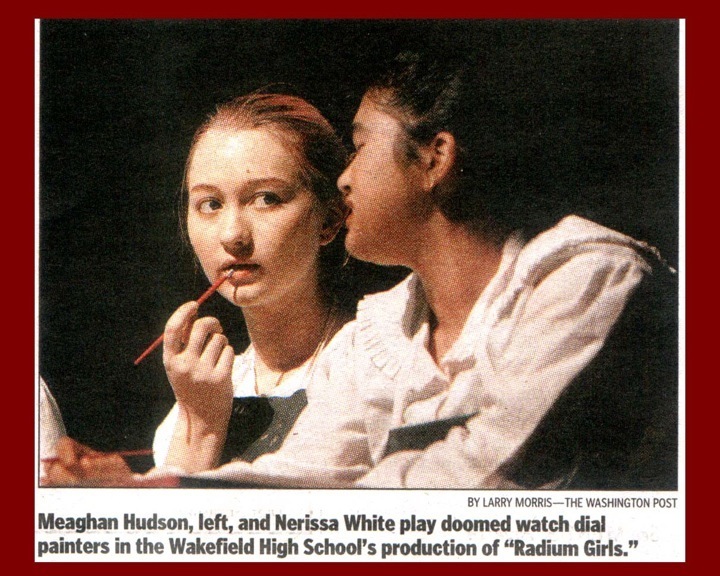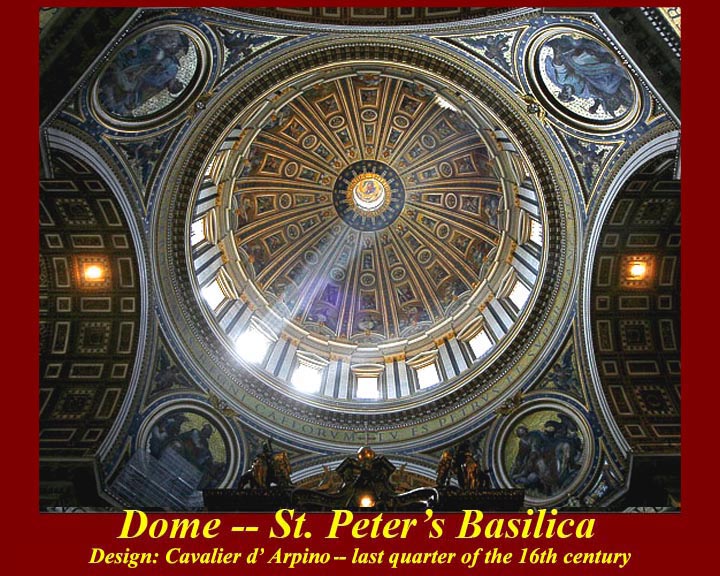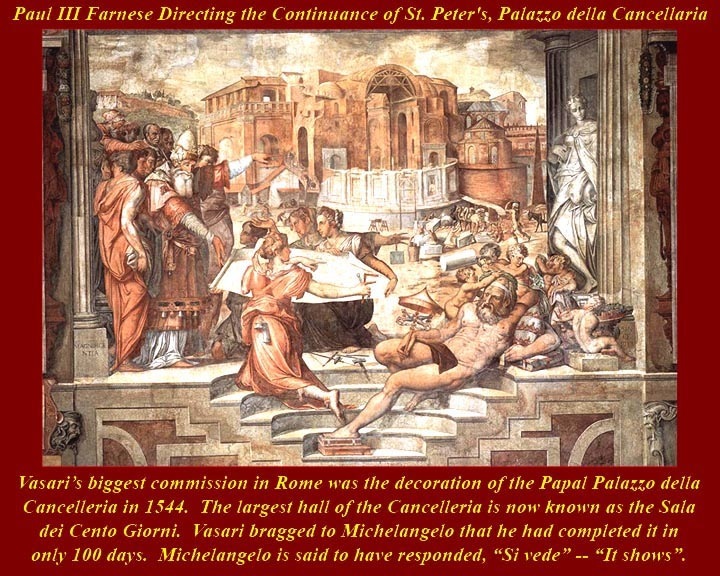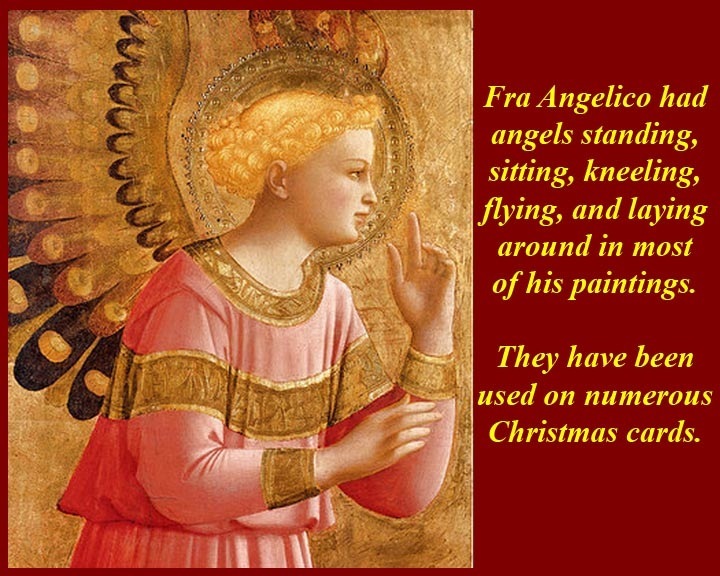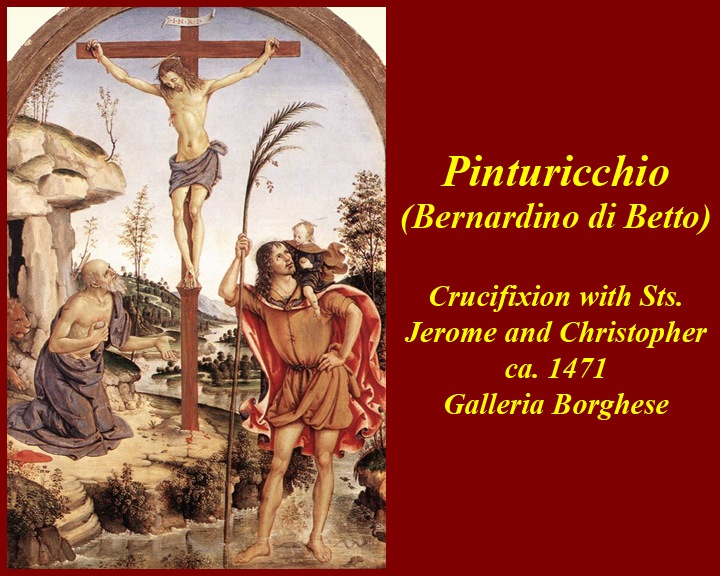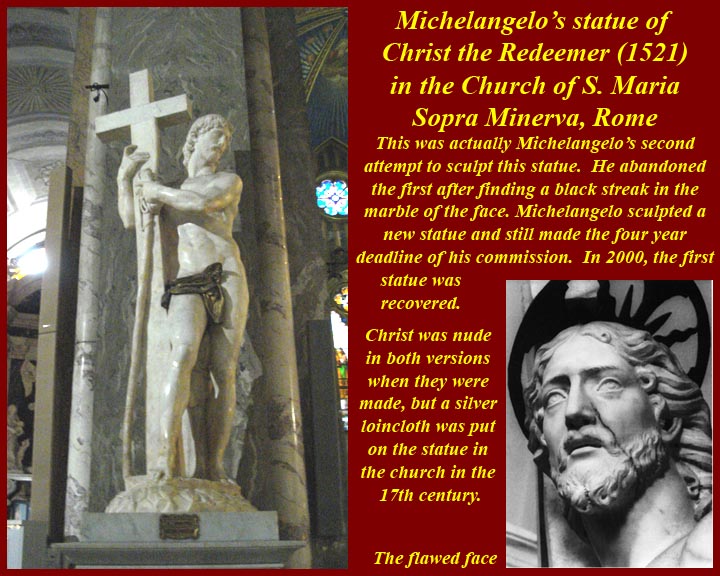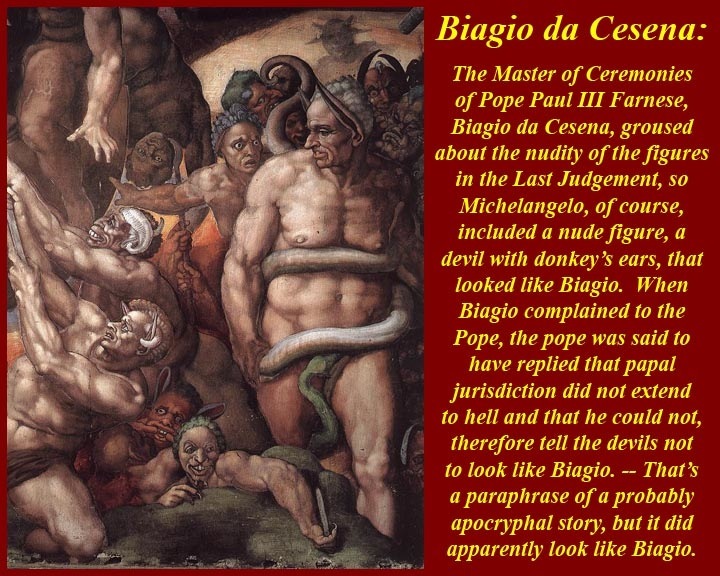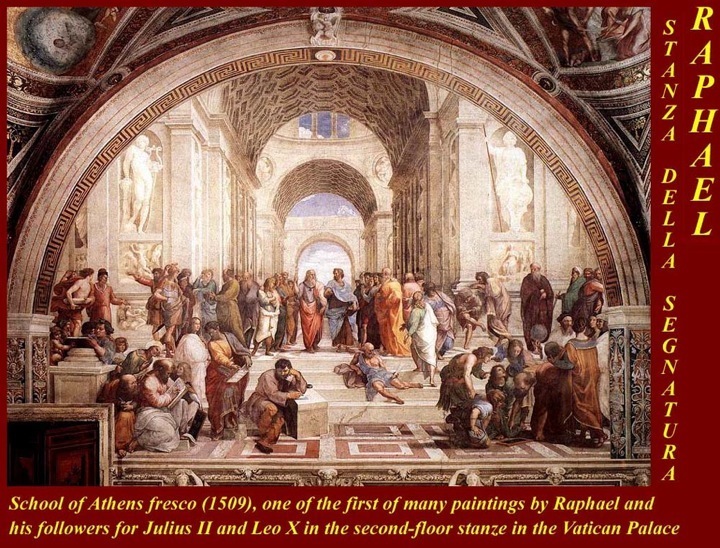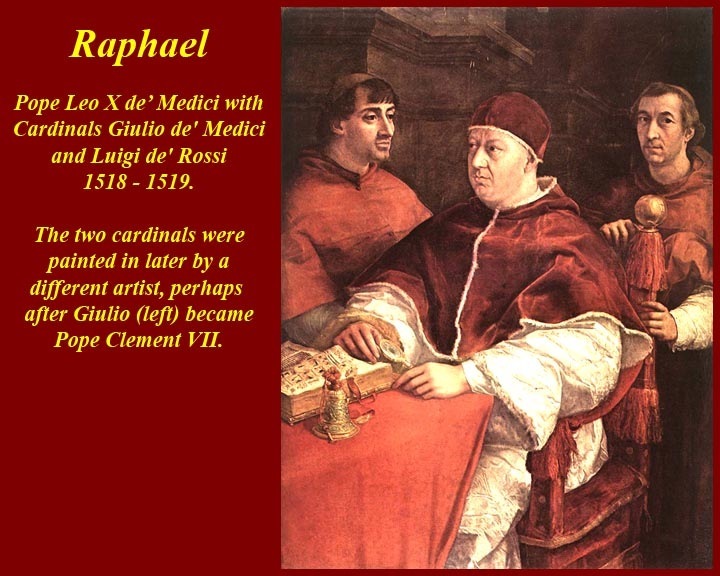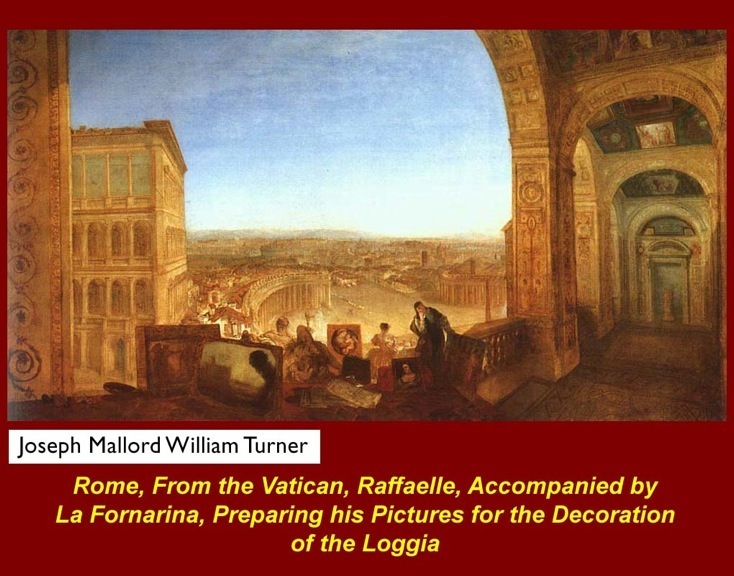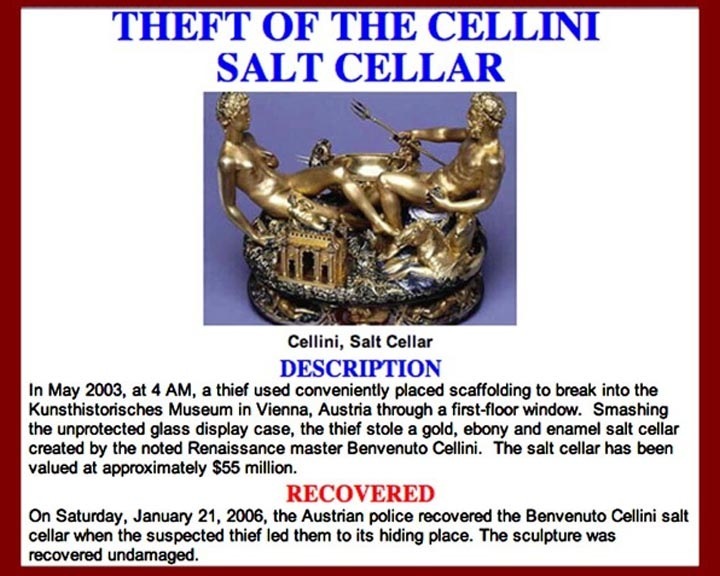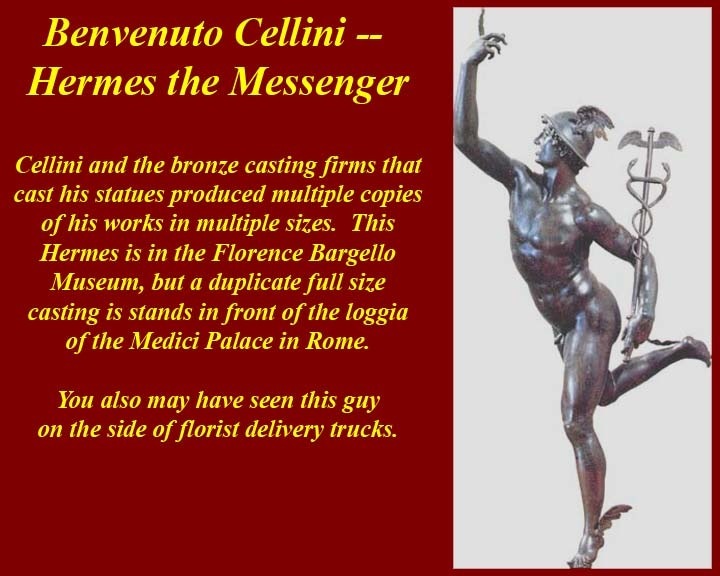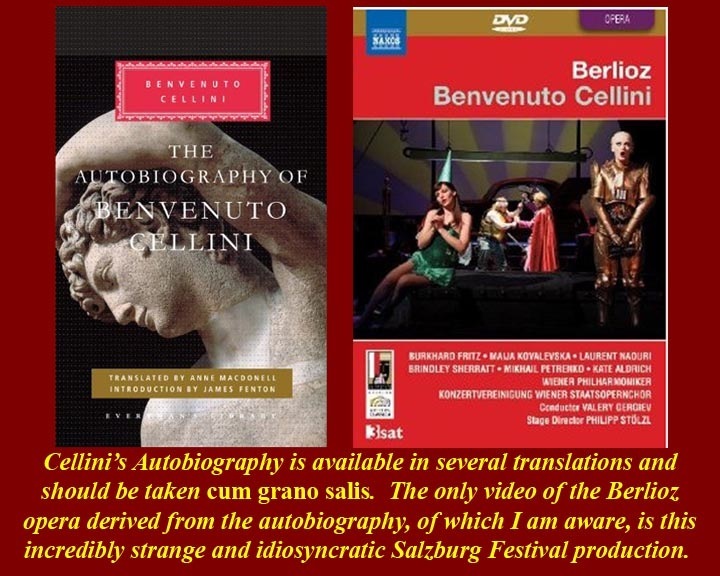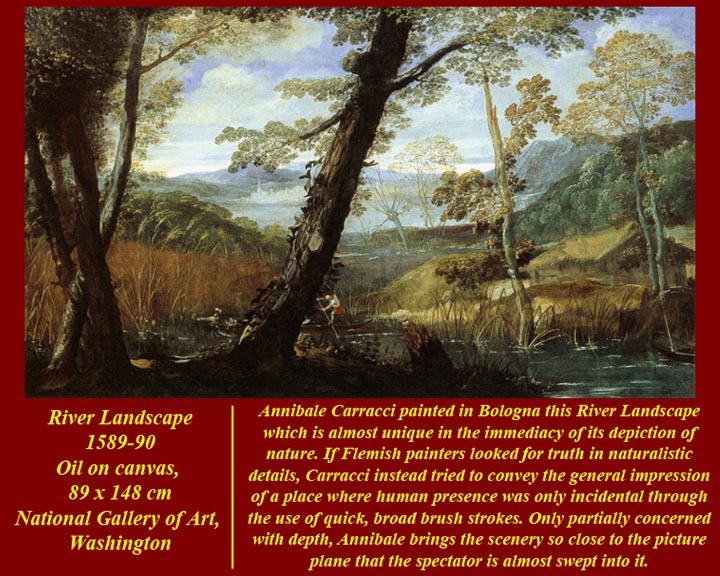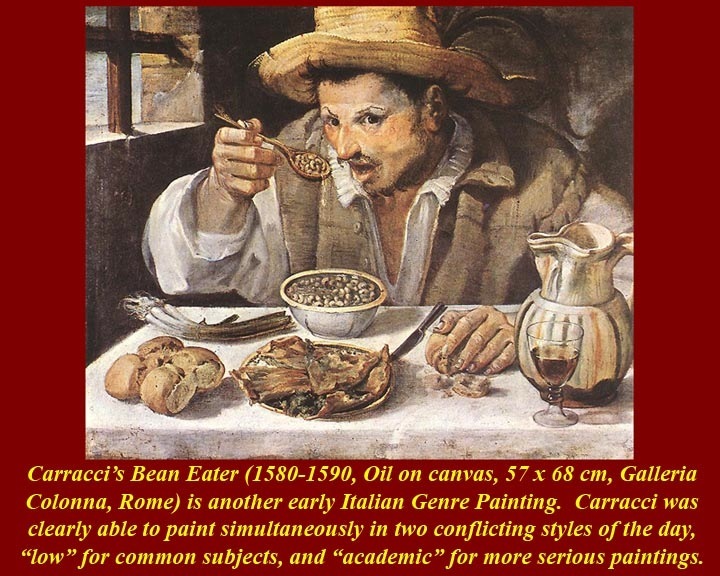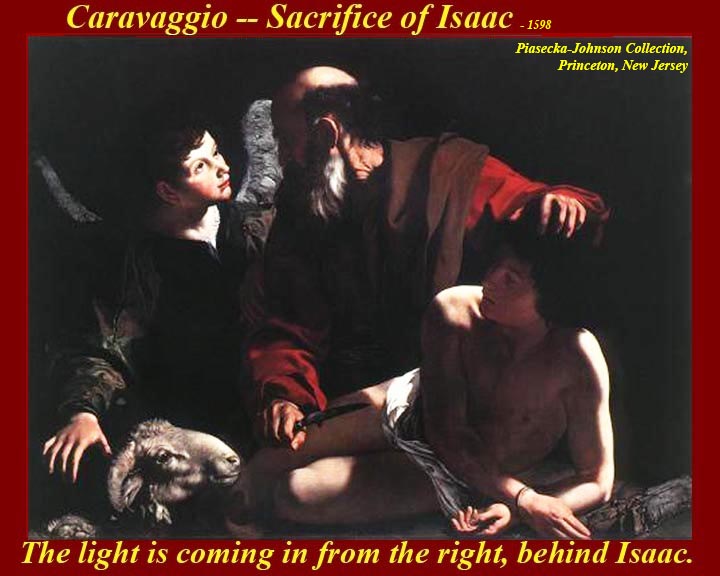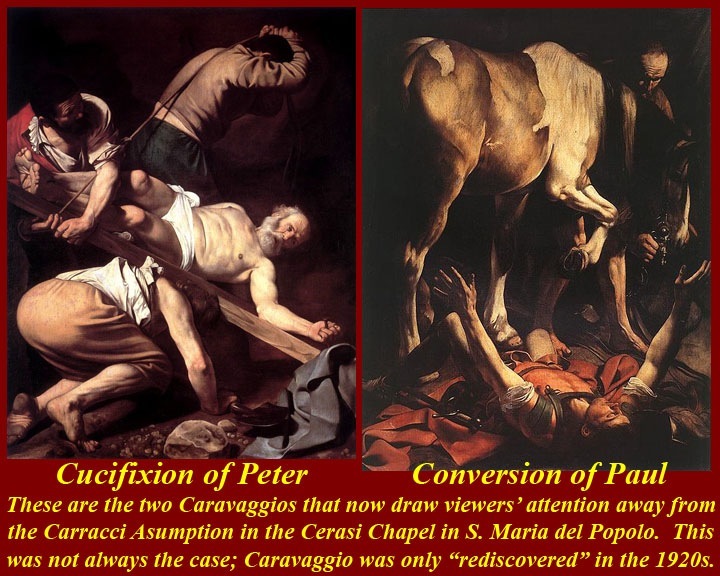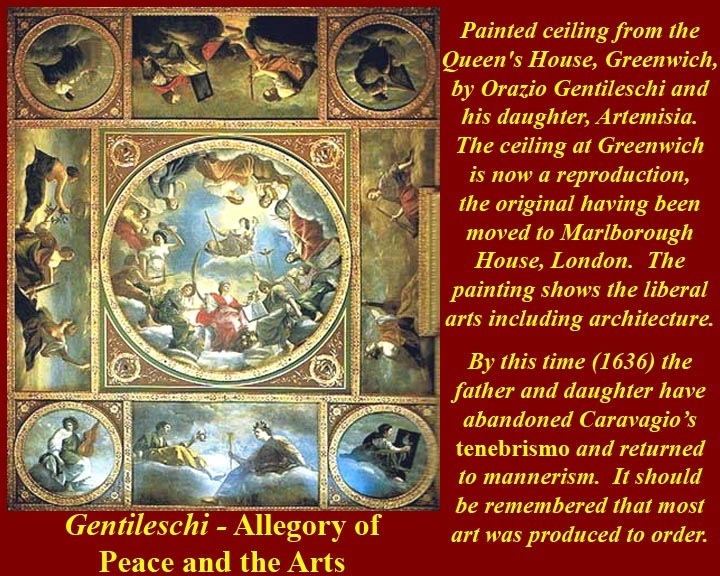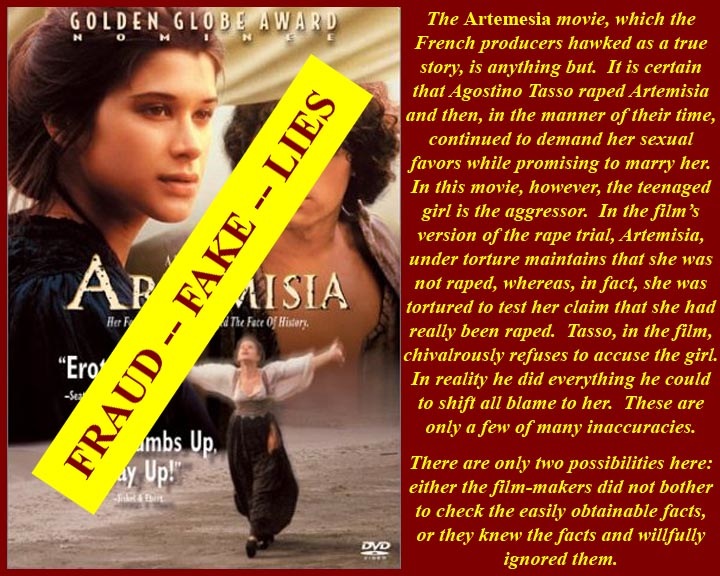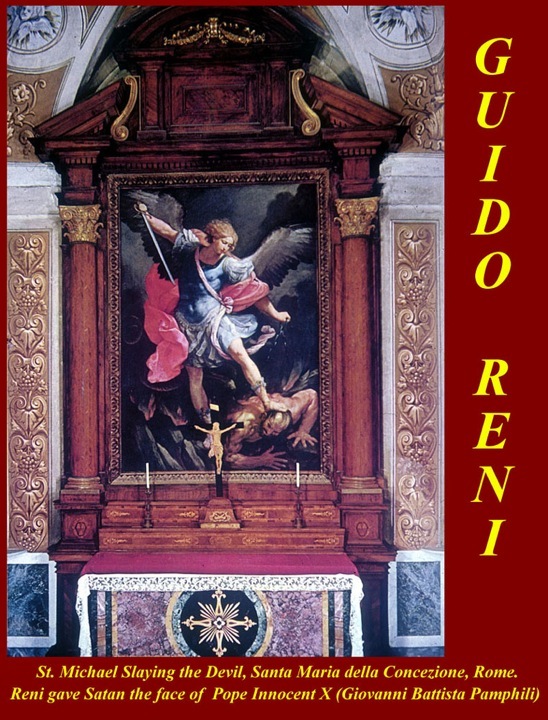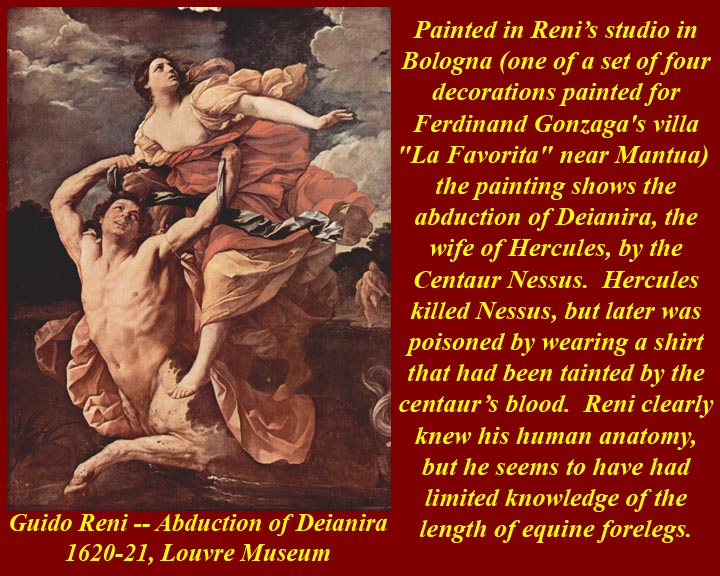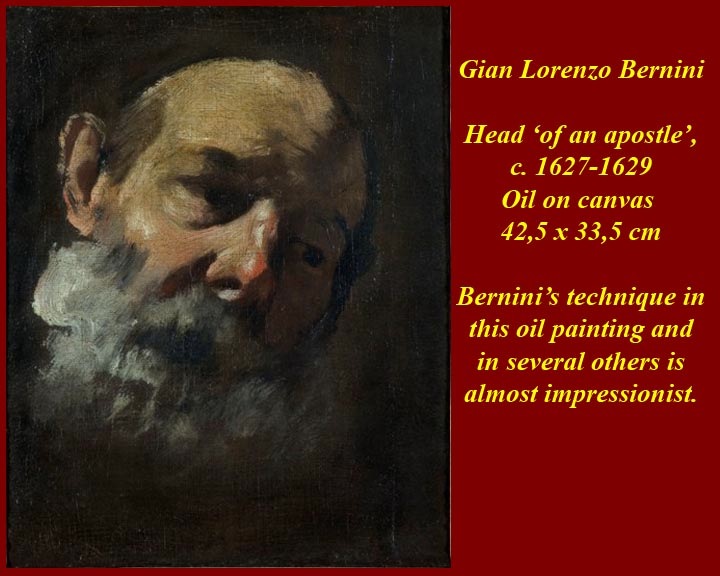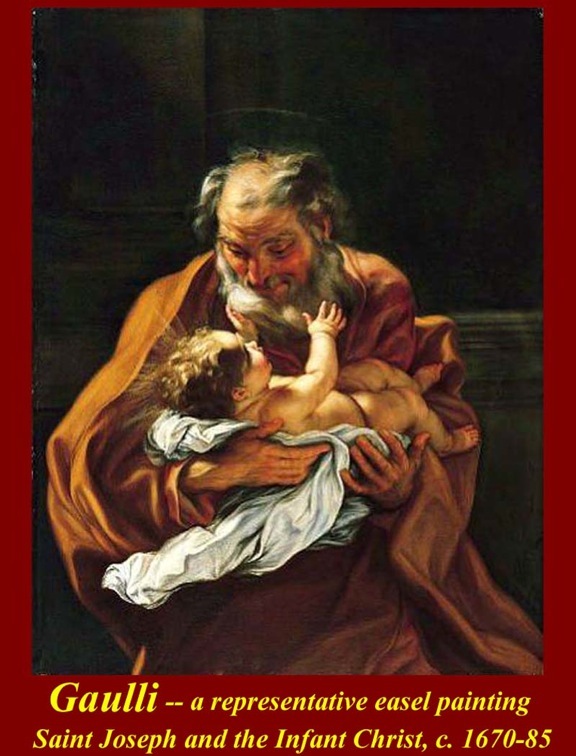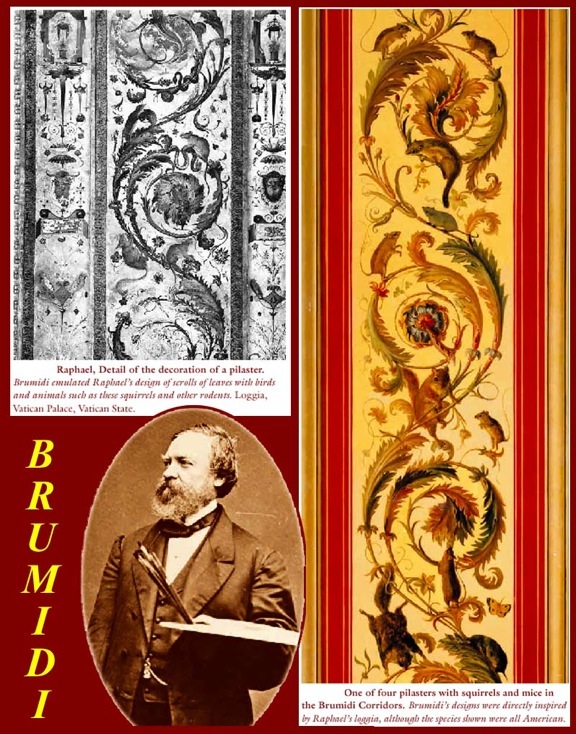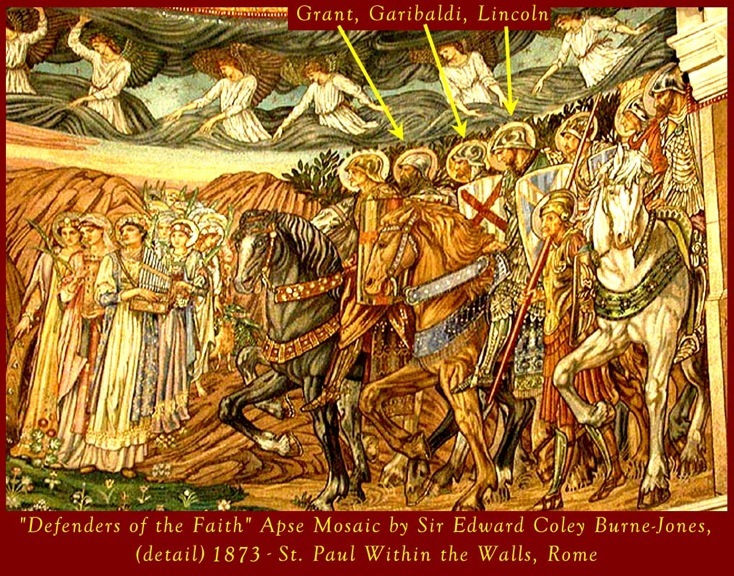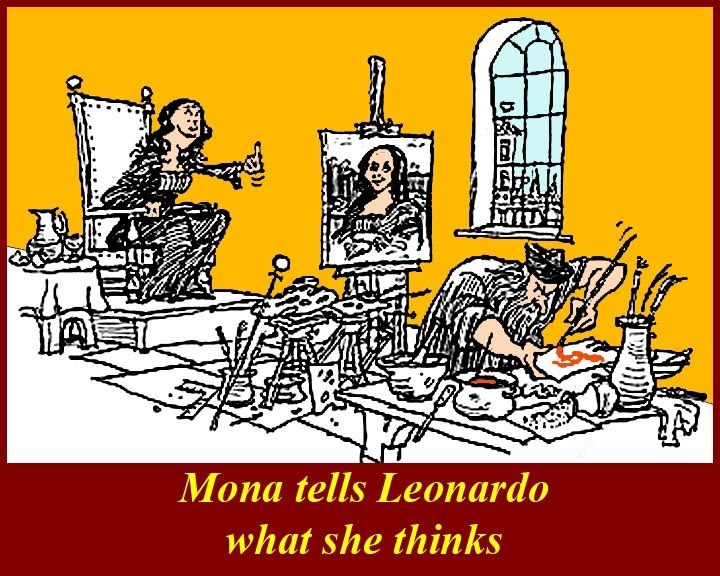Art and ArtistsClick on small images or links below to view larger images for Unit 7
In this unit, as in the last, we will go beyond what particularist "experts" call the Renaissance. We will also delve into the great artistic movements that followed: Baroque, "mannerism", and "Caravaggism".
For a comprehensive view of Renaissance Art in Italy, go to http://arthistoryresources.net/ARTHrenaissanceitaly.html, and use links directly below the main title to go to sections (or manually scroll down). For a listing of thousands of Italian Art and Architecture images archived at the Australian National University, go to http://rubens.anu.edu.au/lists/italy.html, and follow the links.
http://www.mmdtkw.org/RenRom0700c-RadGirls.jpg
Arlington high school girls with an inadvertent Roman Baroque (Caravagisti) look.
Roman Renaissance Mosaics -- a shortage
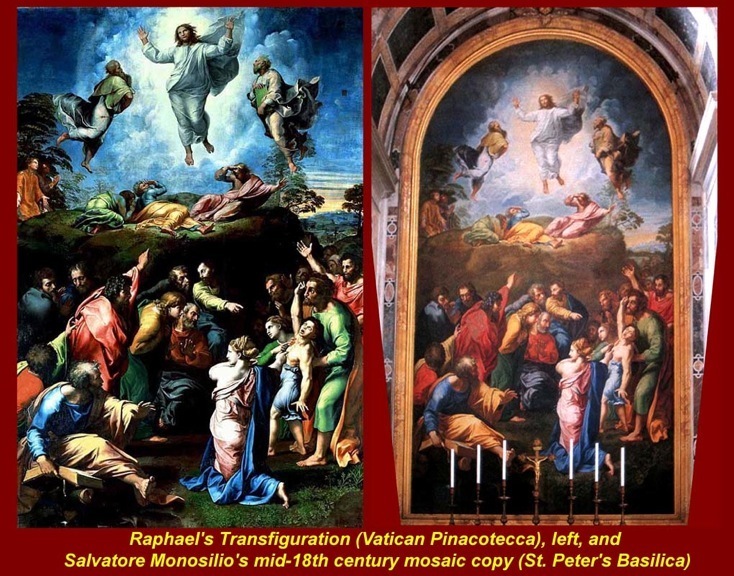
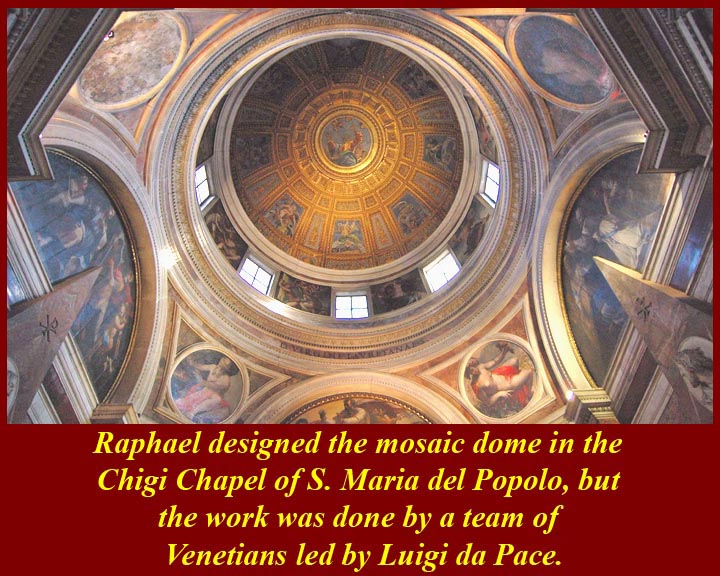
http://www.mmdtkw.org/RenRom0700d-Transfig.jpg
http://www.mmdtkw.org/RenRom0700e-ChigiChapelPopoloMosaic.jpg
http://www.mmdtkw.org/RenRom0700f-PetersDomeMosaic.jpg
Raphael's Transfiguration (1516-1520, oil on wood, 405 cm × 278 cm, Pinacoteca Vaticana) and its mosaic copy in St. Peter's Basilica.
Renaissance artists produced very large scale frescoes and smaller board paintings and canvasses, using the same techniques that had been used by the ancient Romans. To the ancient repertoire of "classical" historic and mythic subject matter, they added, of course, Christian religious and Old Testament subjects. (Oddly, they included the pagan Mediterranean Sibyls along with the Old Testament prophets, based on tortured readings of fake Sibylline prophecies -- see below). What were not produced in the Roman renaissance were very many large scale mosaics comparable to those produced in the ancient and byzantine periods. The reasons for the paucity of mosaics are given in the following excerpt from the Encyclopedia Britannica:
"With the downfall of Byzantium in the 15th century, there perished that milieu in which mosaic had been constantly cultivated and had undergone continuous renewal in response to changing patterns of religious and cultural life. The art lost another foothold in Italy at the beginning of the same century, when changing attitudes about the world and about the function of art eliminated the very bases upon which mosaic had been built. One of the conventions against which the artists of the Renaissance, who were striving for pictorial realism, most strongly rebelled was the use of gold, the other-worldly element most typical of mosaic art.
"Although mosaic continued to be used to a certain extent as church decoration, it was a changed art. Some of its traditional glitter was retained, but essentially mosaics became imitations of painting. These imitative intentions were disastrous and led to the loss of knowledge of how to blend colors and handle materials. In earlier mosaics, there undoubtedly had been a distinction between the leading artist of the project, who drew the composition and oversaw the execution, and the ordinary setters of the tesserae. The leading artist, however, almost certainly took a hand in the setting of special parts and was thoroughly trained in the technical side of the production. Now the preparatory work was divorced from the execution: the artist submitted his cartoon and left its transposition into mosaic to artisans. This drew the lifeblood from the art and caused its degradation.
"In Italy, many of the great painters of the 15th and 16th centuries delivered designs for decorations in mosaic. Best known among these decorations are the works of the Venetian Luigi da Pace after Raphael’s cartoon, in the dome of the Chigi Chapel in Sta. Maria del Popolo in Rome (1516), and the mosaics made after the cartoons of Titian, Tintoretto, Giuseppe Salviati, and Paolo Veronese to complete the decoration of St. Mark’s in Venice. Among the greatest single undertakings of this kind was the decoration of the dome of St. Peter’s in Rome, executed in the last quarter of the 16th century from the cartoons of Cavalier d’Arpino. St. Peter’s also displays some of the most technically striking mosaic reproductions of paintings ever executed—the much admired altar pictures after originals by 16th- and 17th-century masters. Created for the completion and care of the large mosaics of the two great churches, the workshops attached to St. Peter’s and to St. Mark’s gradually became centres for the manufacture of mosaics. From them, artists were summoned for decorative work in all parts of Europe. The school of mosaics in the Vatican and the workshops in Venice still have a considerable share in the field, together with the school more recently set up for the restoration of the mosaics at Ravenna."
("mosaic." Encyclopædia Britannica. 2010. Encyclopædia Britannica Online. 26 Jan. 2010 <http://www.britannica.com/EBchecked/topic/393310/mosaic> (Reading the whole article requires membership.))
Giorgio Vasari (30 July 1511 – 27 June 1574)
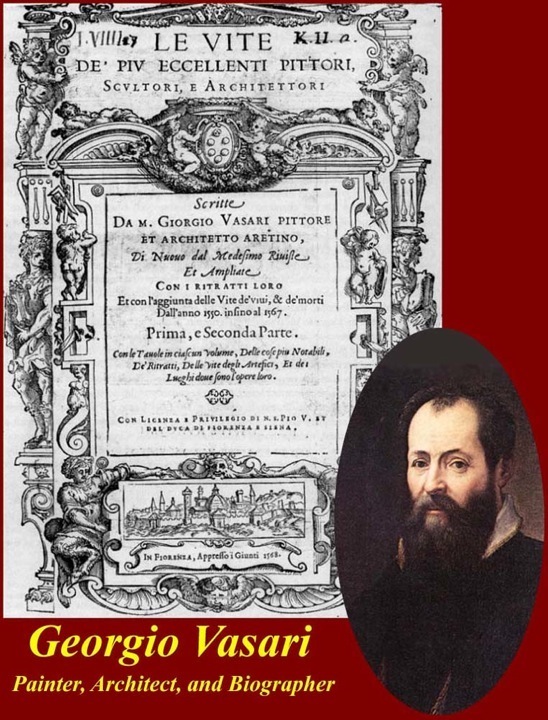
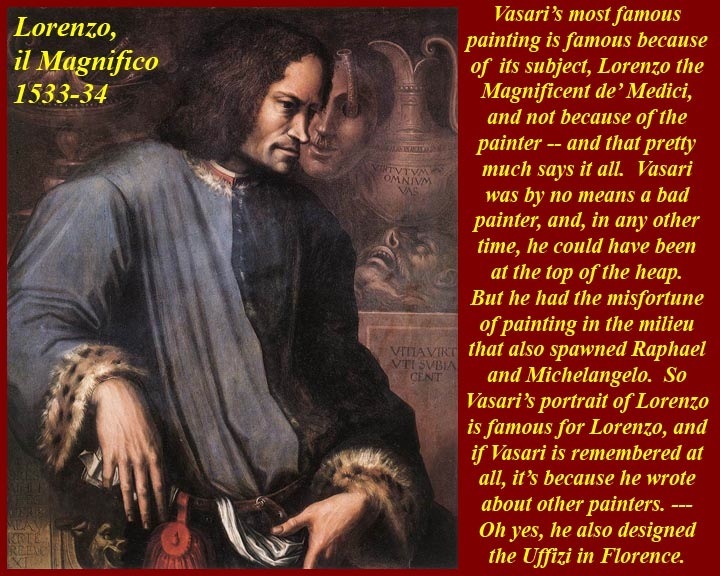
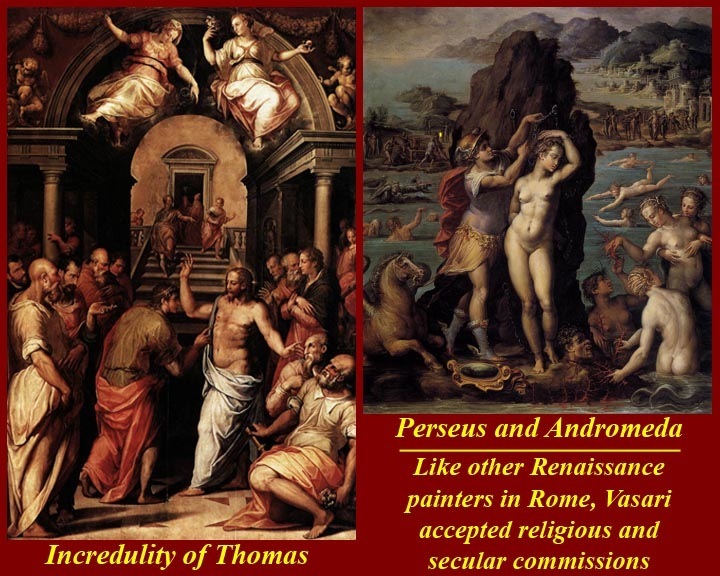
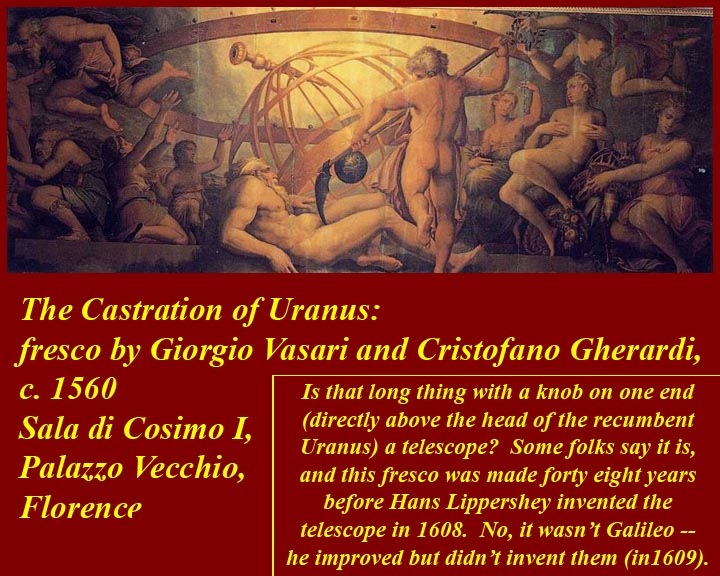
http://www.mmdtkw.org/RenRom0701-VasariLives.jpg
http://www.mmdtkw.org/RenRom0701a-VasariLorenzoMagnifico.jpg
http://www.mmdtkw.org/RenRom0702a-VasariIncredulityThomas.jpg
http://www.mmdtkw.org/RenRom0702b-CastrationOfUranus.jpg
http://www.mmdtkw.org/RenRom0702c-CentoGiorniCancelleria.jpg
Vasari was a second-rate Florentine painter. But he was only second because of the overwhelming mastery of the top three, Leonardo, Michelangelo, and Raphael; any other time or place and he would have been in the top echelon. Only one of his paintings, that of Lorenzo the Magnificent, might be said to be famous, but almost no one would be able to tell you the name of the painter -- it's Lorenzo, the subject, that attracts attention. (The same holds true of his architecture: everyone recognizes the name of the Uffizi Art Museum in Florence, but the same can't be said for the name of its architect, Giorgio Vasari.) So why is Vasari in our list of influential Roman renaissance artists? It's the same story; it's not for his art or architecture, but for what he wrote about other artists and architects in his Le Vite de' Piu Eccellenti Pittori, Scultori, e Architettori, his "Lives". He emulated Plutarch and achieved the same kind of second-hand fame. What we know about the renaissance artists that preceded Vasari often comes from Vasari's Lives. Unfortunately, like Plutarch, Vasari often included myths and fables about his heroes, and like Plutarch, he was a chauvinist, who ignored artists with no Florentine connections and adulated the Florentines. Vasari virtually worshipped Michelangelo, his sometimes master, but when he sought Michelangelo's praise for having completed the frescoes of the great salon of the Cancelleria in Rome in only 100 days, Michelangelo was said to have replied, "Si vede" -- "It shows".
For information on the Vasari's Lives, see http://en.wikipedia.org/wiki/Lives_of_the_Most_Excellent_Painters,_Sculptors,_and_Architects and for many of the Lives in English translation, see http://www.efn.org/~acd/vite/VasariLives.html.
Giorgio Vasari suffered the same fate as that of composer Antonio Salieri's in the late 18th century -- Salieri was a leading composer in his day, but he was just not up to competition with his contemporaries. Most of us only know about Salieri because he was eclipsed by Mozart, and they made a Broadway play and a movie about it. (Salieri was, in fact, thrown even more into the dark by Beethoven who had, for a time, been Salieri's student.)
Fra Angelico (c. 1395 – February 18, 1455)
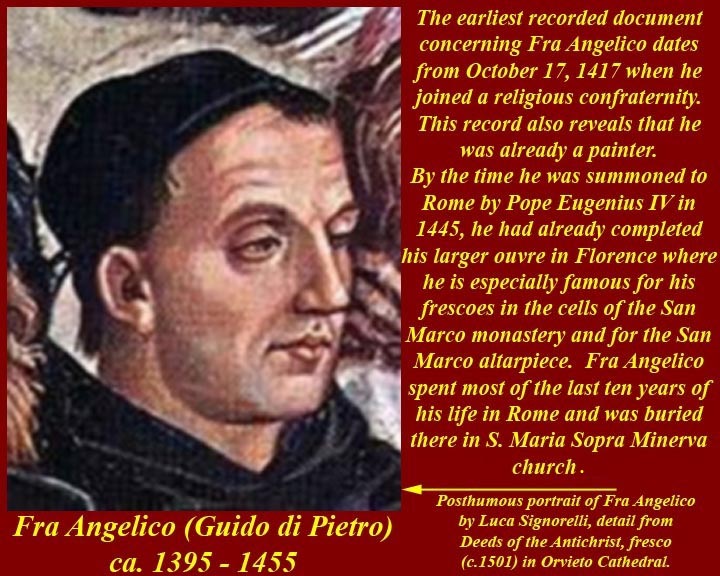
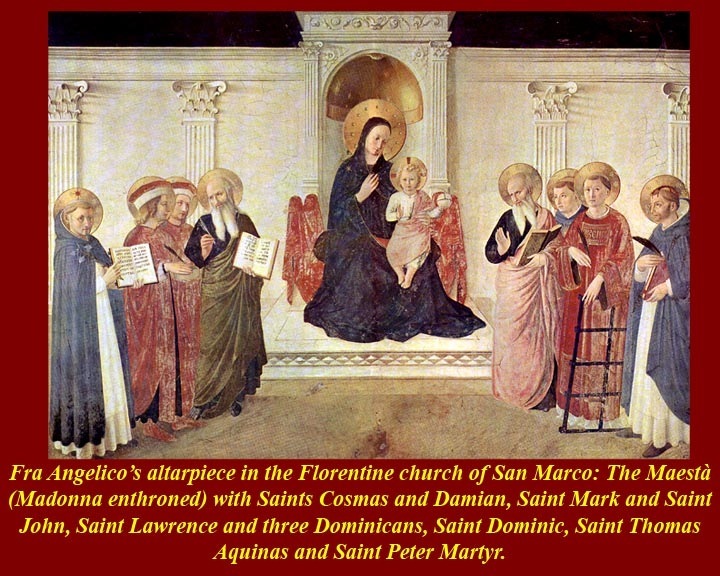
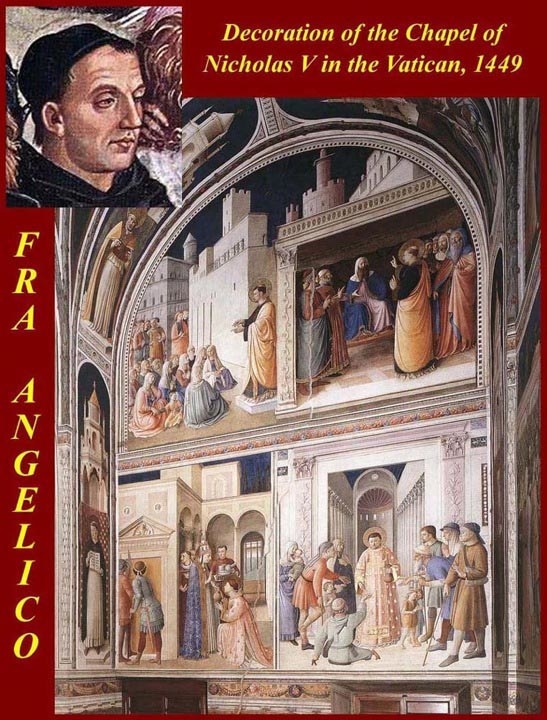
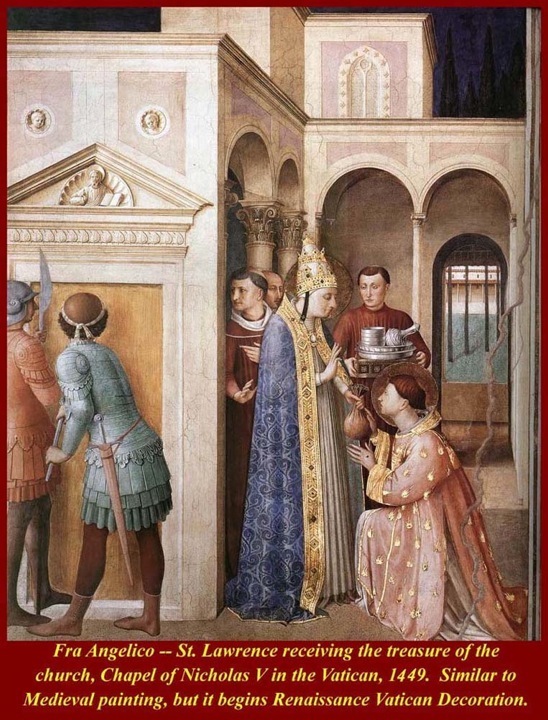
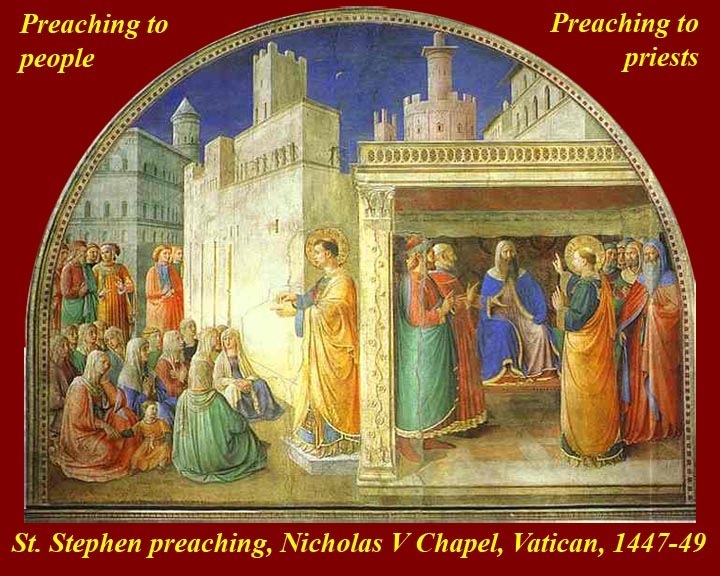
http://www.mmdtkw.org/RenRom0703-FraAngelico.jpg
http://www.mmdtkw.org/RenRom0703a-FraAngelicoSMarcoAltarpiece.jpg
http://www.mmdtkw.org/RenRom0703b-NicholasChapelA.jpg
http://www.mmdtkw.org/RenRom0704-NicholasChapelB.jpg
http://www.mmdtkw.org/RenRom0704a-StephenPerachingNicholas.jpg
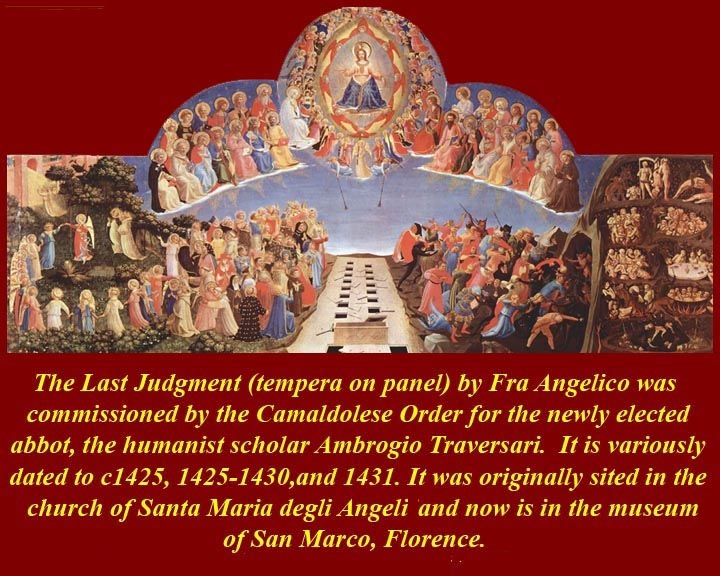
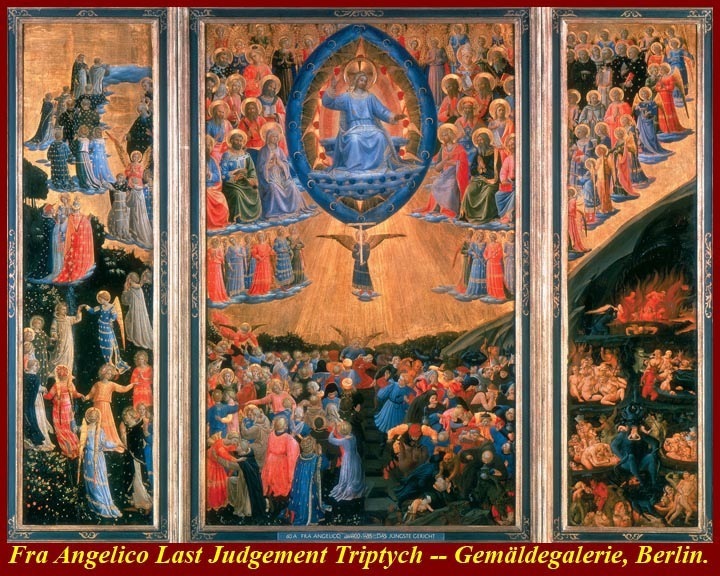
http://www.mmdtkw.org/RenRom0704c-LastJudgement.jpg
http://www.mmdtkw.org/RenRom0704d-LastJudgementTriptych.jpg
http://www.mmdtkw.org/RenRom0704e-FraAngelicoAngel.jpg
Fra Angelico did most of his work in Florence, but he also had a respectable Roman oevre including his frescoes in the Chapel of Pope Nicholas V. He may have completed as many as four fresco cycles in the Vatican between 1445 and 1455, but three of the four are lost. One Painting attributed to him is in S. Maria Sopra Minerva. He he died in Rome in 1455 while resident in the Dominican monastery beside S. Maria Sopra Minerva and is entombed in that church. Fra Angelico included numerous angels with multicolored wings in his paintings, and they are still featured in many Christmas cards. For more information on Fra Angelico, see http://en.wikipedia.org/wiki/Fra_Angelico and http://www.wga.hu/frames-e.html?/html/a/angelico/index.html. For images of many of his paintings, see http://www.wga.hu/frames-e.html?/html/a/angelico/index.html. For an English translation of Vasari's Life of Fran Angelico, see http://www.efn.org/~acd/vite/VasariFraA.html.
Bernardino di Betto, called Pintoricchio or Pinturicchio (1454 – 1513)
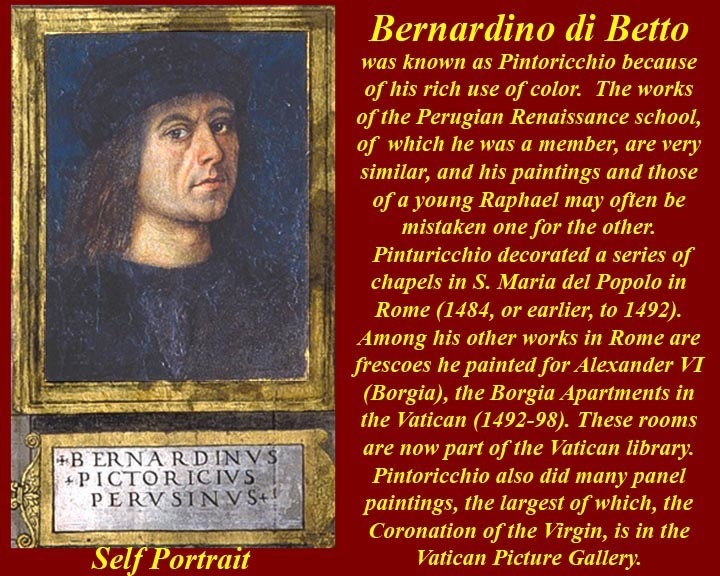
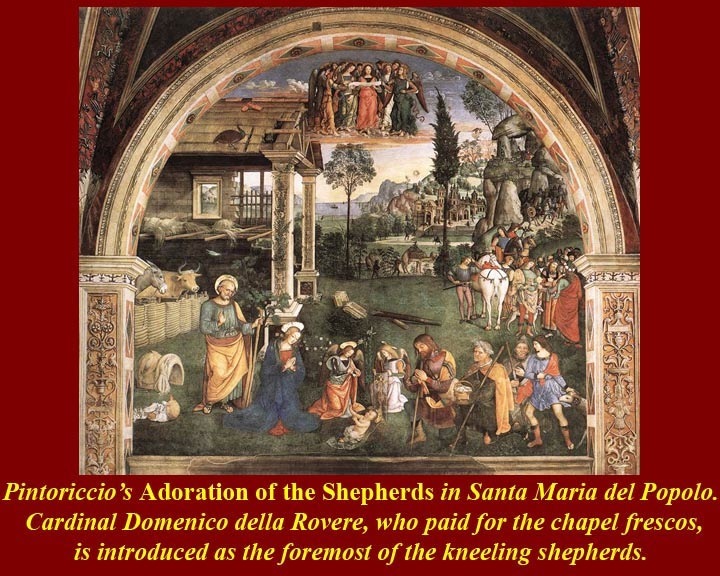
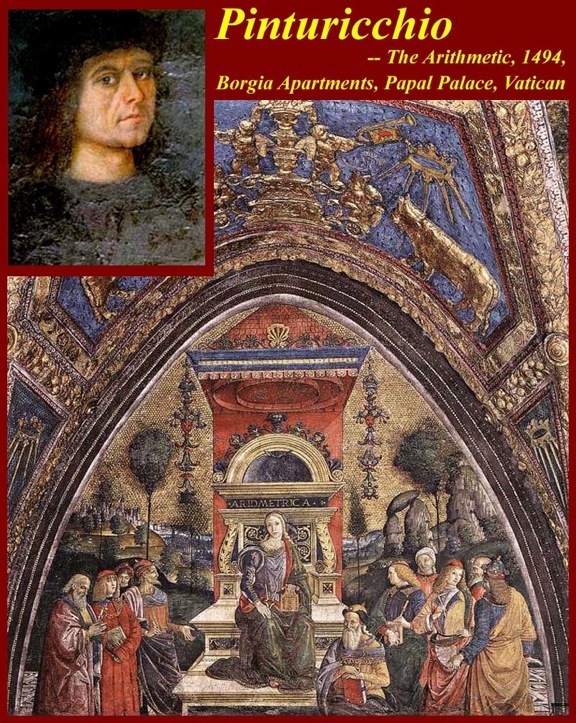
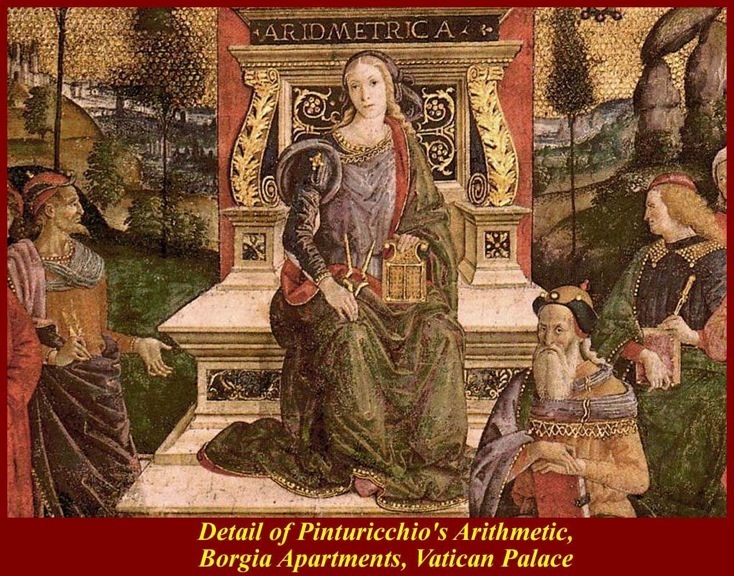
http://www.mmdtkw.org/RenRom0705-PinturicchioSelfPortrait.jpg
http://www.mmdtkw.org/RenRom0705a-AdorationSMPopolo1490.jpg
http://www.mmdtkw.org/RenRom0706-PinturicchioArit.jpg
http://www.mmdtkw.org/RenRom0706a-ArithmeticDetail.jpg
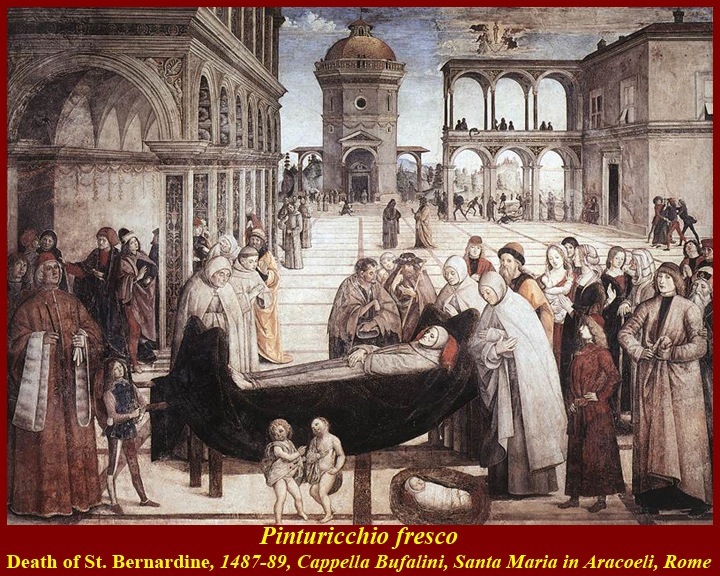
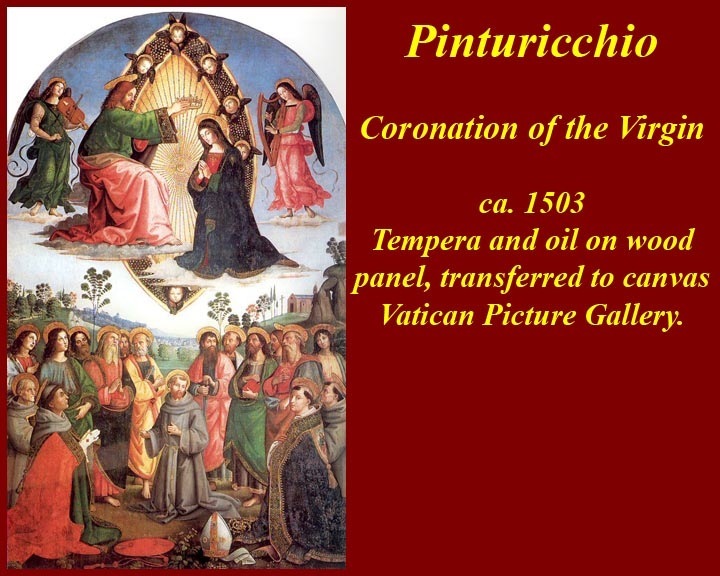
http://www.mmdtkw.org/RenRom0706b-BernardineDeathMariaAracoeli1487.jpg
http://www.mmdtkw.org/RenRom0706c-CoronationVirgin.jpg
http://www.mmdtkw.org/RenRom0706d-Crucifixion.jpg
Bernardino was called Pinturicchio because of his rich use of color, richer even than the use of colors by other members of the Umbrian group of Renaissance painters. The leader of this group, Pietro Vannucci (usually known as Pietro Perugino), at one point, employed Pinturiccho and the styles of those two, along with Giovanni di Pietro ("Lo Spagno") and the young Raphael were so similar that their works are often confused. After assisting Perugino in his frescoes on the walls of the Sistine Chapel, Pinturicchio was employed by various members of the Della Rovere family and others to decorate a series of chapels in the church of Santa Maria del Popolo in Rome, where he appears to have worked from 1484, or earlier, to 1492. The earliest of these is an altarpiece of the Adoration of the Shepherds. After a sojourn in Orvieto, where he painted in the Cathedral, he returned to Rome and was employed by Pope Alexander VI (Borgia) to decorate a recently built suite of six rooms, the Appartamenti Borgia in the Vatican. These rooms now form part of the Vatican library, and five still retain a series of Pinturicchio frescoes. (The sixth was repainted later by another artist.) The Vatican picture gallery has the largest of Pinturicchio's panels — the Coronation of the Virgin, with the apostles and other saints below. Several well-executed portraits occur among the kneeling saints.
For information on Pinturicchio see http://en.wikipedia.org/wiki/Pinturicchio and http://www.wga.hu/frames-e.html?/bio/p/pinturic/biograph.html. For images of some of his paintings, including those in the Borgia apartments in the Vatican, see http://www.wga.hu/frames-e.html?/bio/p/pinturic/biograph.html. For Vasari's biography, see http://www.efn.org/~acd/vite/VasariPinturicchio.html.
Michelangelo di Lodovico Buonarroti Simoni (6 March 1475 – 18 February 1564)
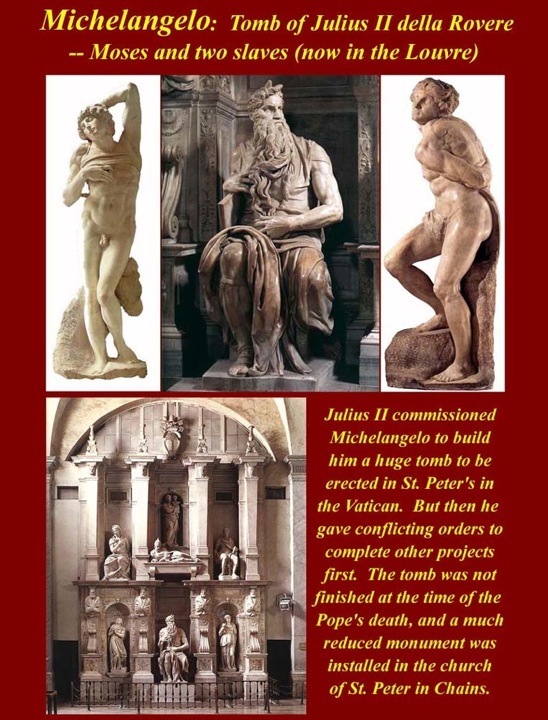
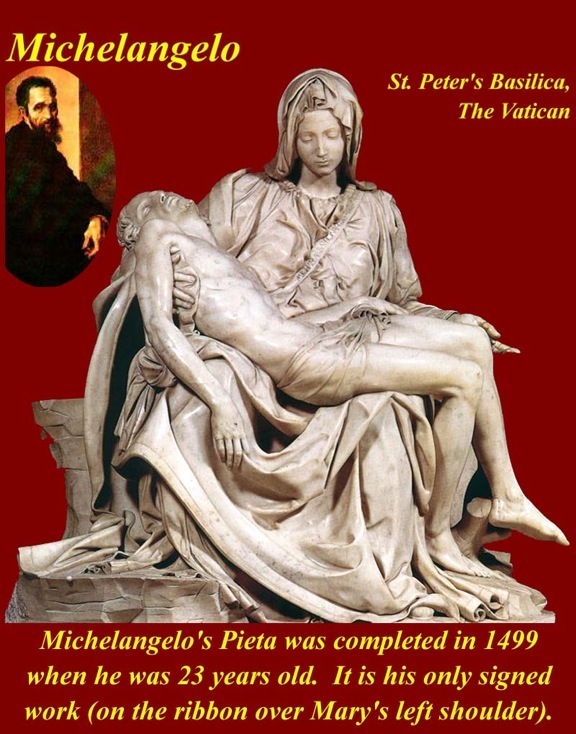
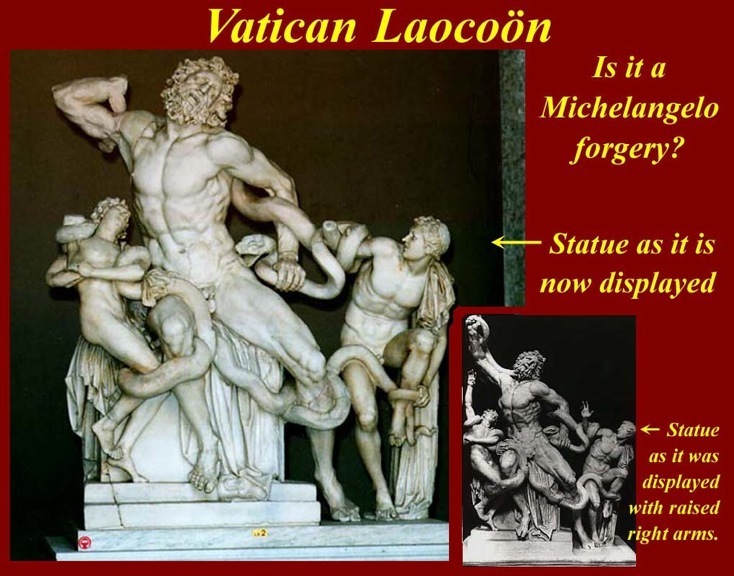
http://www.mmdtkw.org/RenRom0707-MichelangeloMose.jpg
http://www.mmdtkw.org/RenRom0708-MichelangeloPiet.jpg
http://www.mmdtkw.org/RenRom0708a-Laocoon.jpg
http://www.mmdtkw.org/RenRom0708b-MichelangeloChristRedeemSMMinerva.jpg
Michelangelo always seems to have considered himself a sculptor (not a painter) and his Roman sculptures are exquisite. He was working on a huge tomb for Julius II when Julius assigned him the distracting task of painting the Sistine Chapel -- so distracting that the tomb was curtailed and only a much smaller version, featuring Michelangelo's Moses, was completed after the death of Julius.
His Pieta in St. Peters, completed in 1499 when the sculptor was just 23 years old, is justly famous as is his David in Florence, which he finished in 1504. The Vatican Laocoon was a discovered rather than a sculpted statue -- maybe.
A statue of Laocoon is attributed by the Roman author Pliny the Elder to three Rhodian sculptors: Agesander, Athenodoros and Polyclitus. It showed, according to Pliny, the Trojan priest Laocoön and his sons Antiphantes and Thymbraeus being strangled by sea serpents (because he had warned the Trojans about "Greeks bearing gifts"). In 2005 Lynn Catterson argued that the sculpture was a forgery created by Michelangelo. Richard Brilliant, author of My Laocoön, described Catterson's claims as "noncredible on any count". Michelangelo was involved in discussions about needed restorations, but Raphael provided the new upraised right arm that was attached to Laocoon. It wasn't until the 1950s that the original arm, discovered in 1906, was installed in place of Raphael's arm (which is now attached to the back of the base of the statue). As Michelangelo had surmised, the original arm was bent back toward the head of Laocoon.
Michelangelo's Christo del Minerva statue is Michelangelo's own replacement for a statue of a nude Christ the Redeemer, which he abandoned uncompleted after finding a black streak in the marble of the face of his first effort. The original streaked statue was rediscovered in 2000. Both versions suffer from reworking by less able sculptors, but the Christo del Minerva in Rome's Santa Maria Sopra Minerva church is less damaged -- attachment of a silver loincloth in the 17th century damaged the statue's right hip and genitals.
Michelangelo's work in the Sistine Chapel
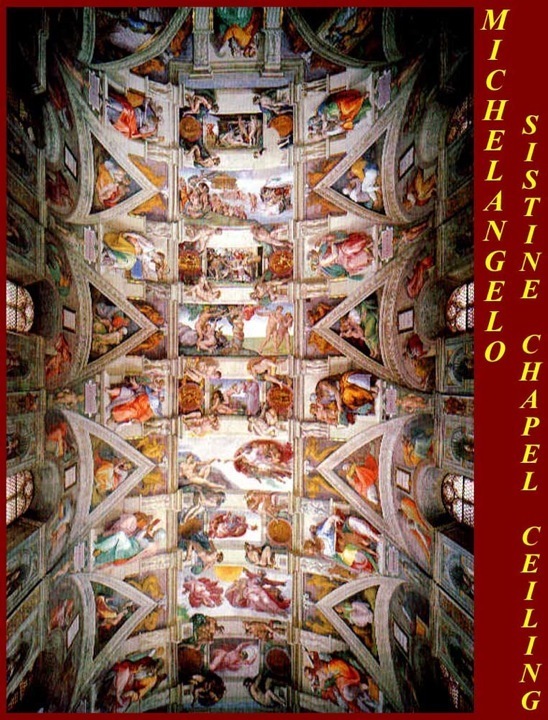
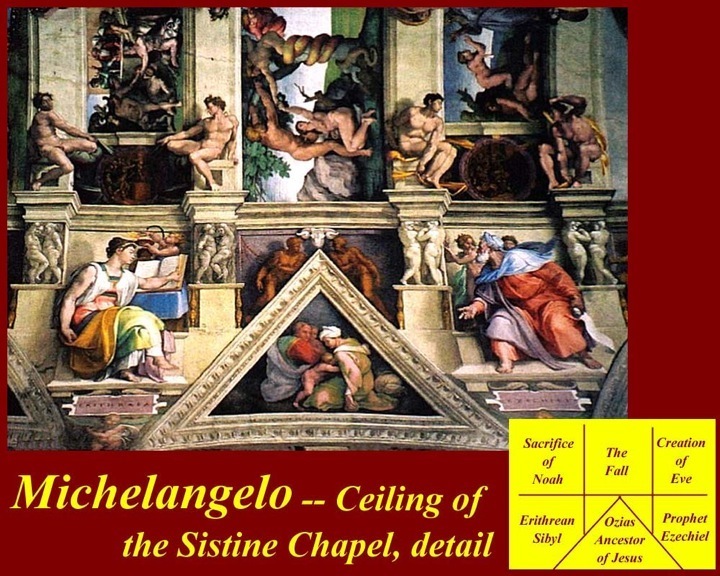
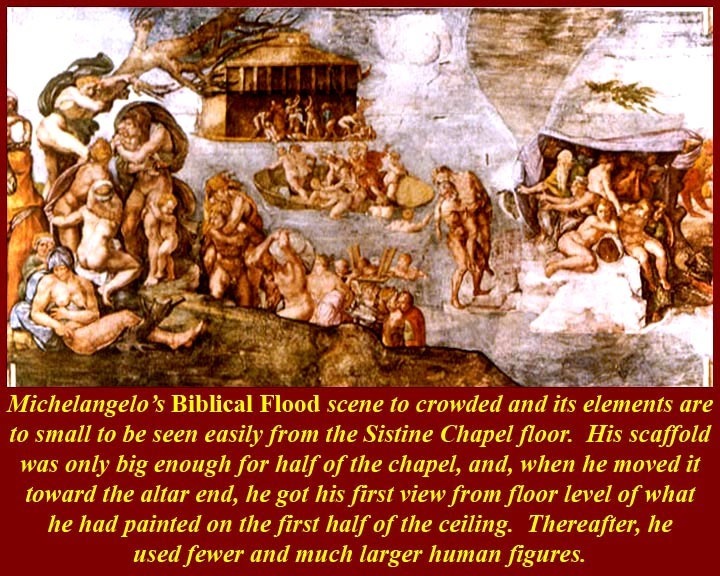
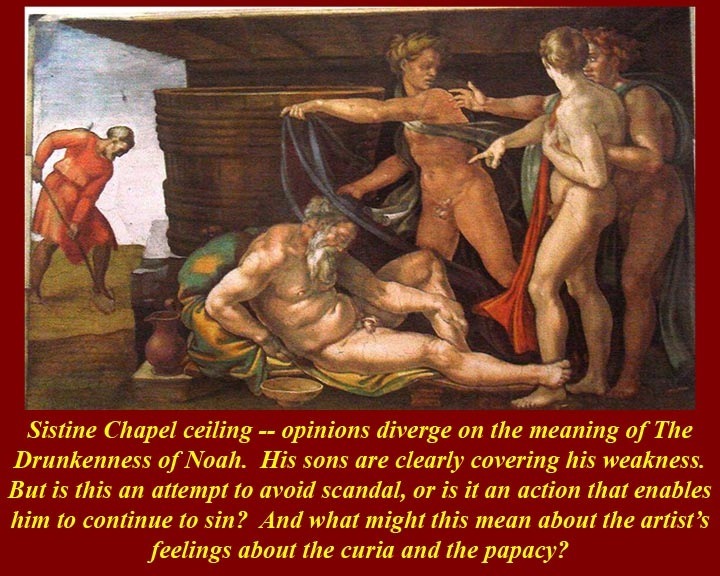
http://www.mmdtkw.org/RenRom0709-SistineCeil1512.jpg
http://www.mmdtkw.org/RenRom0709a-SistineCeilDeta.jpg
http://www.mmdtkw.org/RenRom0709b-BiblicalFlood.jpg
http://www.mmdtkw.org/RenRom0709c-DrunkenNoah.jpg
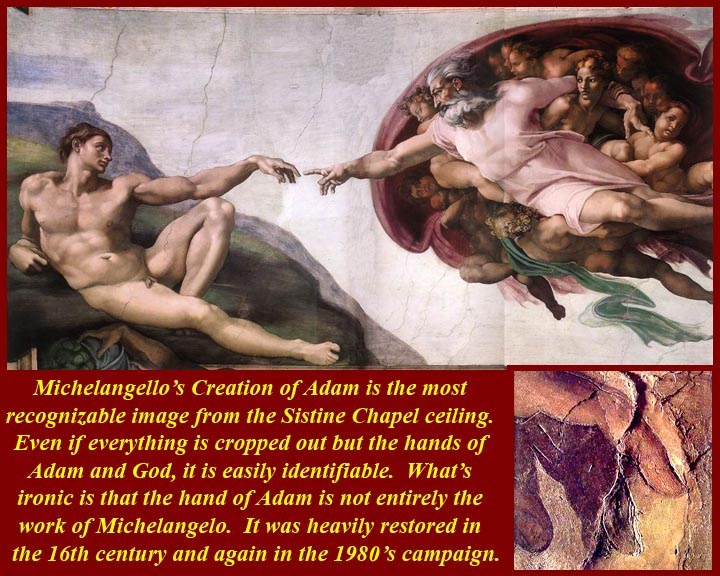
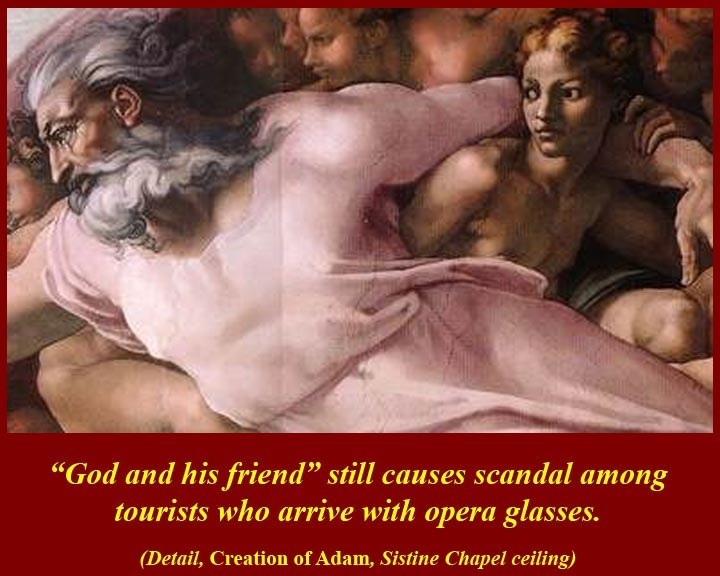
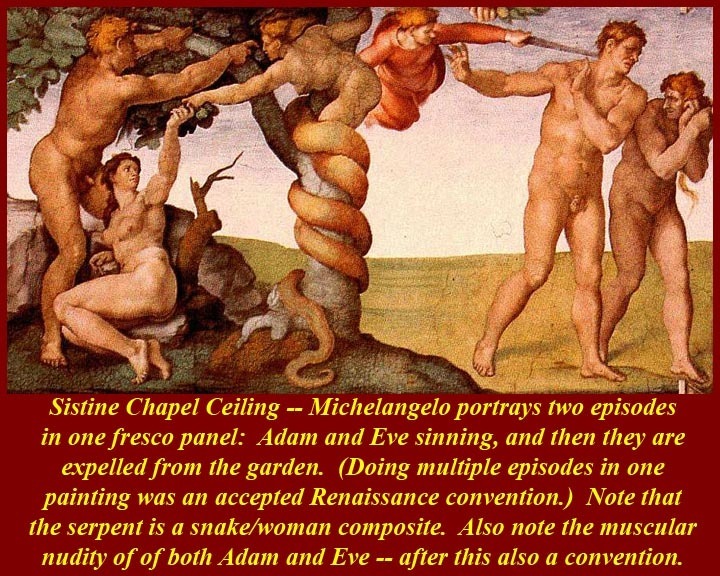
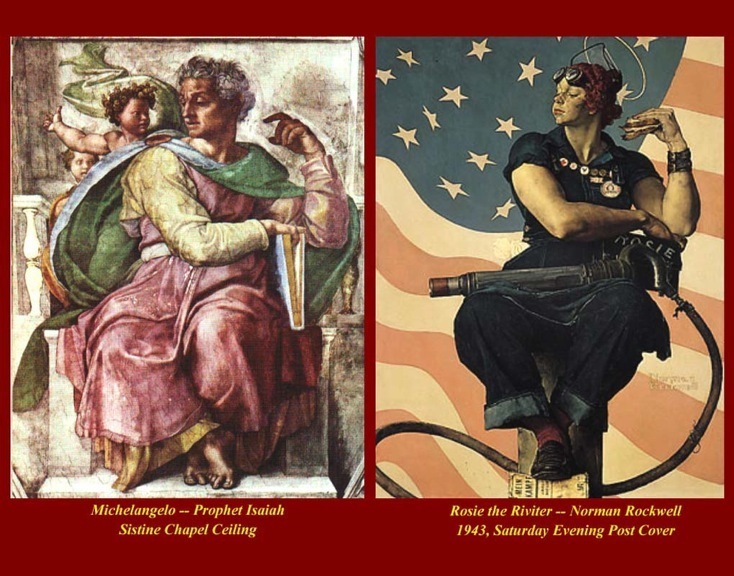
http://www.mmdtkw.org/RenRom0709d-CreationofAdam.jpg
http://www.mmdtkw.org/RenRom0709d1-GodAndFriend.jpg
http://www.mmdtkw.org/RenRom0709e-AdamEve.jpg
http://www.mmdtkw.org/RenRom0709f-IsaiahRosie.jpg
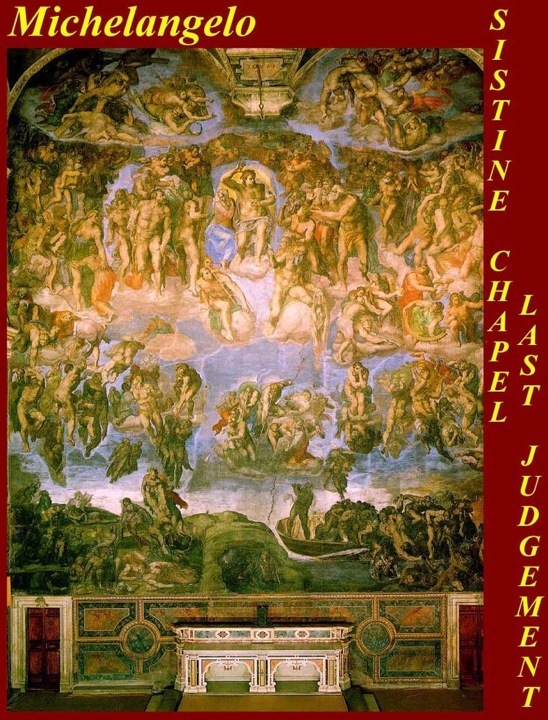
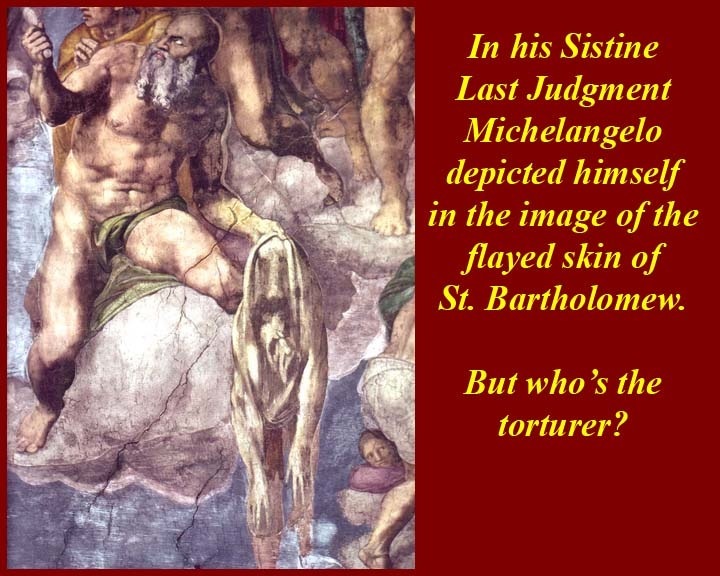
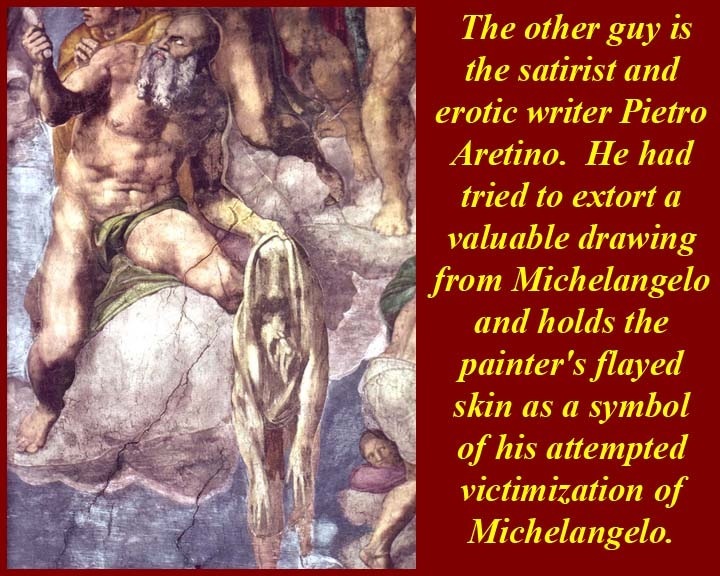
http://www.mmdtkw.org/RenRom0710-LastJudge1536.jpg
http://www.mmdtkw.org/RenRom0710a-LastjudgementBatholomewMichelangelo.jpg
http://www.mmdtkw.org/RenRom0710b-LastJudgementBartHolder.jpg
http://www.mmdtkw.org/RenRom0710c-BiagioDaCasena.jpg
Michelangelo's work on the Sistine Chapel ceiling (1508 - 1512) for Julius II is well known from Irving Stone's "biographical novel" The Agony and the Ecstasy and from Hollywood's adaptation of the novel with Charlton Heston and Rex Harrison. Unfortunately, almost everything in the book and the movie was much more novel than biography -- no, Pope Julius did not have a Brittish accent. There are a few hints of fact about the painting of the Sistine Chapel ceiling, but if you want the real story, read Michelangelo and the Pope's Ceiling by Ross King (who also wrote about Brunelleschi's Dome on the Florence Duomo).
When Michelangelo painted the ceiling, his scaffold was not built up from the floor, but rather it was suspended from the tops of the walls; the floor had to be kept clear for important papal religious ceremonies. Since wood in the quantities needed was expensive, the scaffold only stretched for half the length of the chapel. Michelangelo and his crew (no, he wasn't the lone painter from the movie) didn't have a floor level view of the completed first half until the scaffold was disassembled and rebuilt to paint the second half of the ceiling. Their view was revealing -- the central panels in the first half were to crowded with small human figures. When Michelangelo painted the central panels of the second half they only had a few large protagonists.
It should also be noted that our image of Michelangelo painting the ceiling lying on his back with paint dripping on his face is innacurate. He and his helpers always painted standing upright, and, in fact, in letters writen to his brother, Michelangelo complained about the severe pain of arching his back for hours as he reached overhead to apply the pigments; in one letter he even incuded a sketch of himself in that painful position. Perhaps he would have been much more comfortable in a prone position.
Michelangelo also frescoed the end wall behind the altar in the Sistine Chapel for Paul III. His Last Judgement (1537 - 1541) is a depiction of the second coming of Christ and the apocalypse. The souls of humans rise and descend to their fates, as judged by Christ (ChristosPantokrator = Χριστός Παντοκράτωρ) surrounded by his saints. Unlike the ceiling of the chapel, this extended altarpiece (13.7 x 12 meters) is a single picture. The nudity of the characters on the painting brought much controversey during Michelangelo's lifetime, and after his death, many genitals in the fresco were covered by the artist Daniele da Volterra, whom history remembers by the derogatory nickname "Il Braghettone" ("the breeches-painter").
The "mannereist" school of painting which swept through Rome at the end of our period was based on the sometimes exaggerated human forms painted by Michelangelo, a convention copied in Raphael's later works and often ascribed solely to him. In fact the works of both artists inspired the mannerists, and the 19th century "Pre-Raphaelites" used Raphael's name in rejecting mannerism (-- they probably didn't want to be called the "pre-Michelangelo-ite brotherhood"). For more information on mannerism, see http://en.wikipedia.org/wiki/Mannerism and https://www.khanacademy.org/humanities/renaissance-reformation/mannerism1/a/a-beginners-guide-to-mannerism.
For more information on Michelangelo's Sistine Chapel works, see http://www.artbible.info/art/sistine-chapel.html and http://en.wikipedia.org/wiki/Sistine_Chapel and http://mv.vatican.va/3_EN/pages/CSN/CSN_Main.html. The best site for Sistine Chapel frescoes images is http://www.christusrex.org/www1/sistine/0-Tour.html. There are hundreds of thousands of Internet sites concerned with Michelangelo's work in the Sistine chapel.
For a brief biography of Michelangelo, see http://en.wikipedia.org/wiki/Michelangelo or http://www.wga.hu/frames-e.html?/bio/m/michelan/biograph.html or http://www.michelangelo.com/buon/bio-index2.html. For Vasari's Life of Michelangelo see http://www.efn.org/~acd/vite/VasariMA.html (short version) and http://www.efn.org/~acd/vite/VasariMAngelo.html (long version).
Raffaello Sanzio da Urbino (April 6 or March 28, 1483 – April 6, 1520
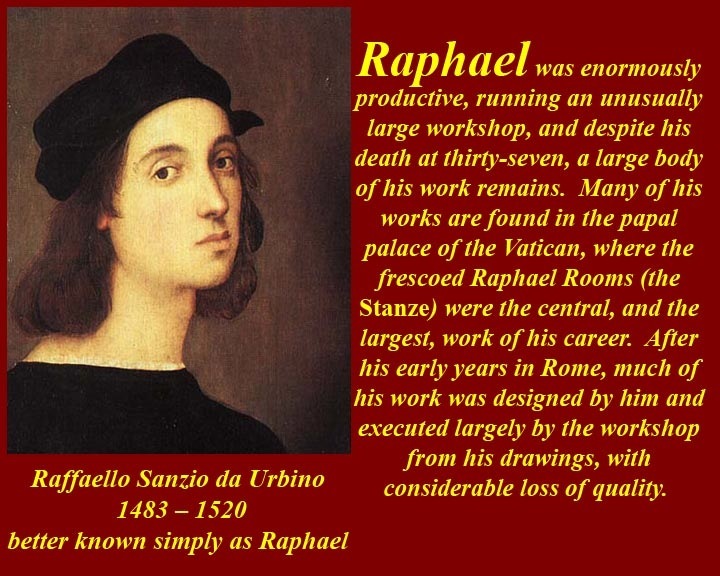
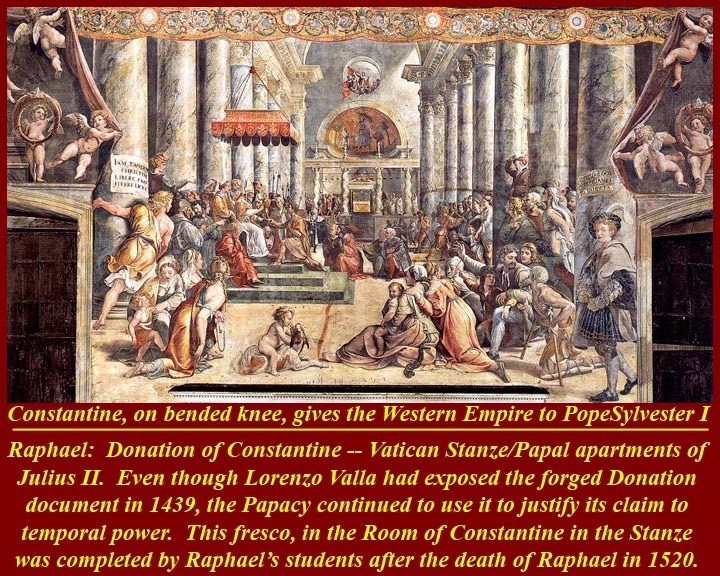
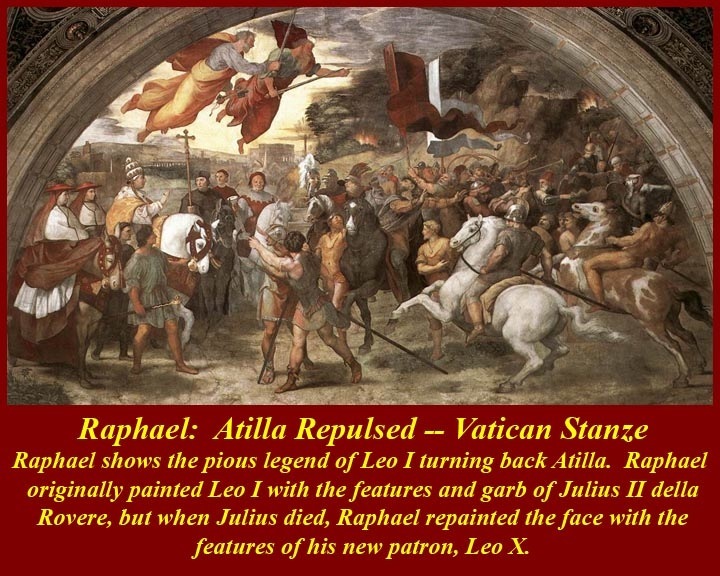
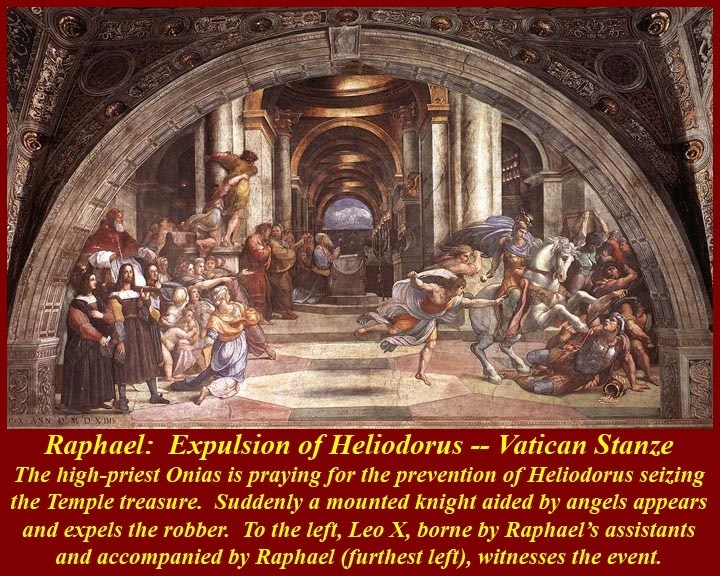
http://www.mmdtkw.org/RenRom0711-Raphael.jpg
http://www.mmdtkw.org/RenRom0711a-Donationconstantine.jpg
http://www.mmdtkw.org/RenRom0711b-LeoAttila.jpg
http://www.mmdtkw.org/RenRom0711c-Heliodorus.jpg
http://www.mmdtkw.org/RenRom0711d-RaphaelAthens.jpg
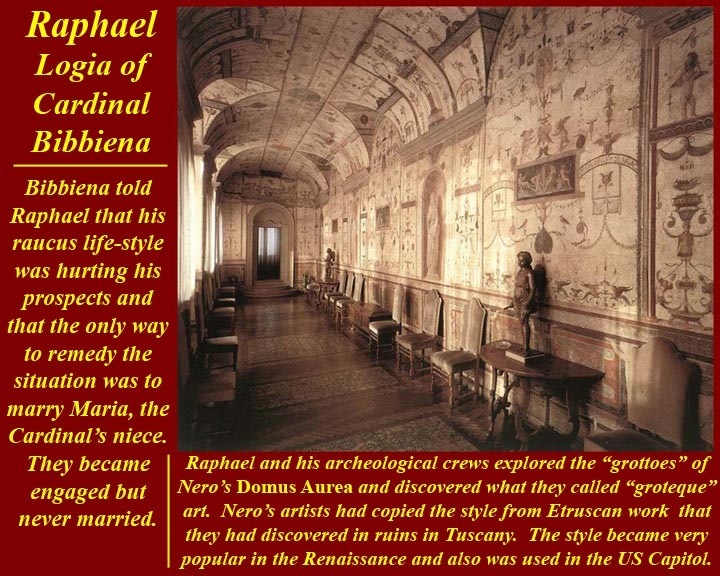
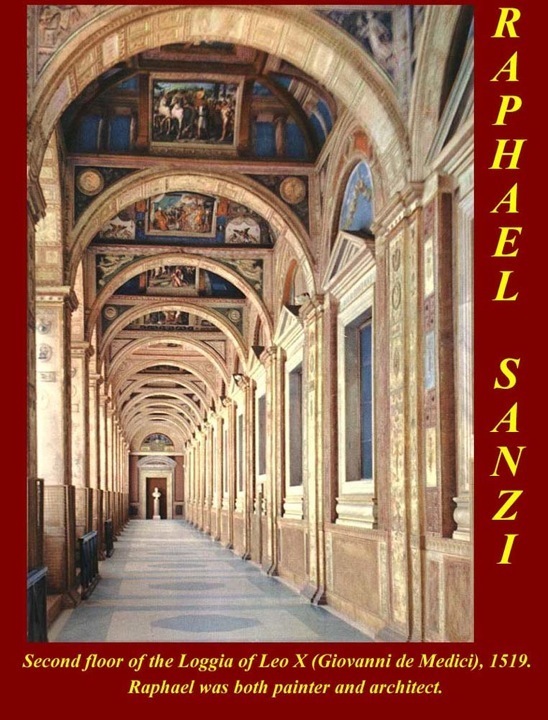
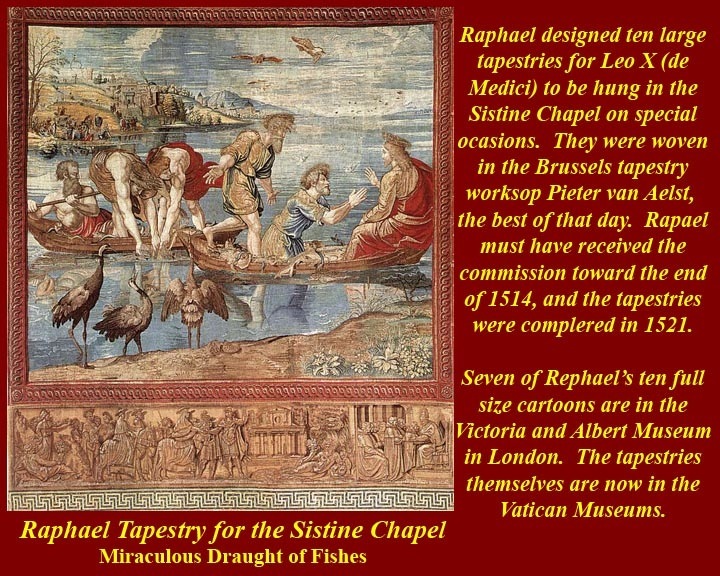
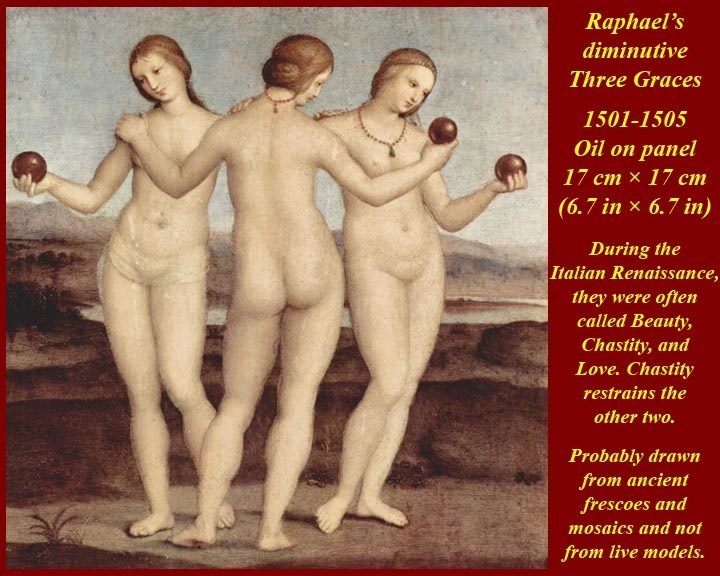
http://www.mmdtkw.org/RenRom0712-RaphaelLoggetta.jpg
http://www.mmdtkw.org/RenRom0712a-RaphaelLoggia.jpg
http://www.mmdtkw.org/RenRom0712b-RaphaelSistineTapestry.jpg
http://www.mmdtkw.org/RenRom0713-ThreeGraces.jpg
http://www.mmdtkw.org/RenRom0713a-LeoX.jpg
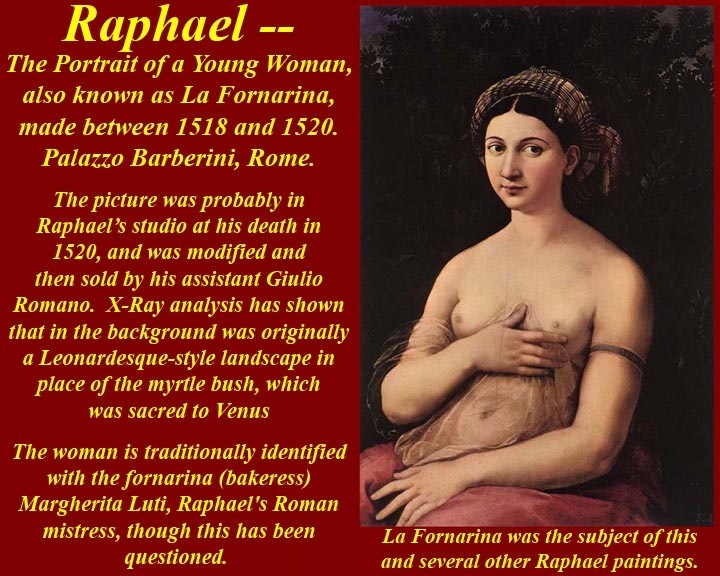
http://www.mmdtkw.org/RenRom0714-RaphaelFornarina.jpg
http://www.mmdtkw.org/RenRom0714a-RaphaelFornar2.jpg
If Michelangelo was a semi-recluse, Raphael was a playboy/man-about-town. His Roman patron and "protector" (and he needed one of those) was Bernardo Dovizi (Cardinal Bibbiena), who, fearing that Raphael's carousing and womanizing would get him kicked out of his Vatican commissions, arranged Raphael's engagement to his niece, Maria Bibbiena. The marriage never took place, because Raphael kept putting it off until she died -- some said of a broken heart. When Raphael died young (due to his debauchery) and was entombed in the Pantheon (Santa Maria ad Martyres Church) in Rome, his will requested that she be disinterred and entombed beside him. His act of belated conscience was honored.
The most important of Raphael's Vatican commissions was for the Stanze ("rooms" or apartment) of Julius II della Rovere. There was already a suite of rooms, the Borgia Apartments, but Julius so hated Alexander VI Borgia Borgia and his reputation that he refused to inhabit the same space as his predecessor. He also painted a loggia for Cardinal Bibbiena, in which he introduced to the Roman canon of art the "Grotesque" style that he and his crews had found while exploring the "grottoes" of Nero's Domus Aurea. He designed and executed another loggia for Leo X de'Medici using grotesque and other styles from the Domus Aurea. Other artists and architects immediately copied this style, which was also emulated in US Government buildings by Constantino Brumidi in the 19th century.
While engaged to Maria Bibbiena, Raphael continued his public affair with his mistress, "La Fornarina", traditionally identified as Margherita Luti, the daughter of a Trastevere baker.
The "mannerist" school of painting which swept through Rome at the end of our period was based on the sometimes exaggerated human forms painted by Michelangelo, a convention copied in Raphael's later works and often ascribed solely to him. In fact the works of both artists inspired the mannerists, and the 19th century "Pre-Raphaelites" used Raphael's name in rejecting mannerism (-- they probably didn't want to be called the "pre-Michelangelo-ite brotherhood"). For more information on mannerism, see http://en.wikipedia.org/wiki/Mannerism.
For more information on Raphael, see http://en.wikipedia.org/wiki/Raphael and http://www.artchive.com/artchive/R/raphael.html and http://www.artcyclopedia.com/artists/raphael.html and http://www.newadvent.org/cathen/12640c.htm.
Raphael's known works can be viewed at http://www.wga.hu/frames-e.html?/html/r/raphael/index.html and his Vatican works are available at http://www.christusrex.org/www1/stanzas/0-Raphael.html.
Benvenuto Cellini (3 November 1500 – 13 February 1571)
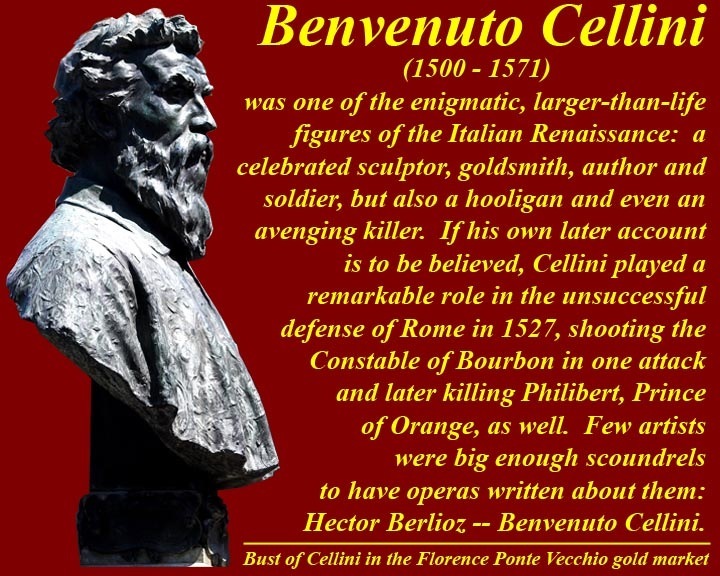
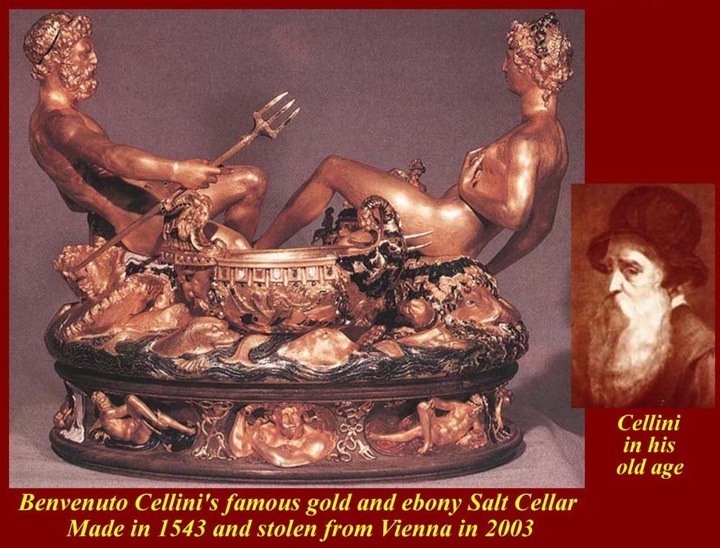
http://www.mmdtkw.org/RenRom0715-CelliniBust.jpg
http://www.mmdtkw.org/RenRom0715a-CelliniSaltCell.jpg
http://www.mmdtkw.org/RenRom0715bSaltcellRecov.jpg
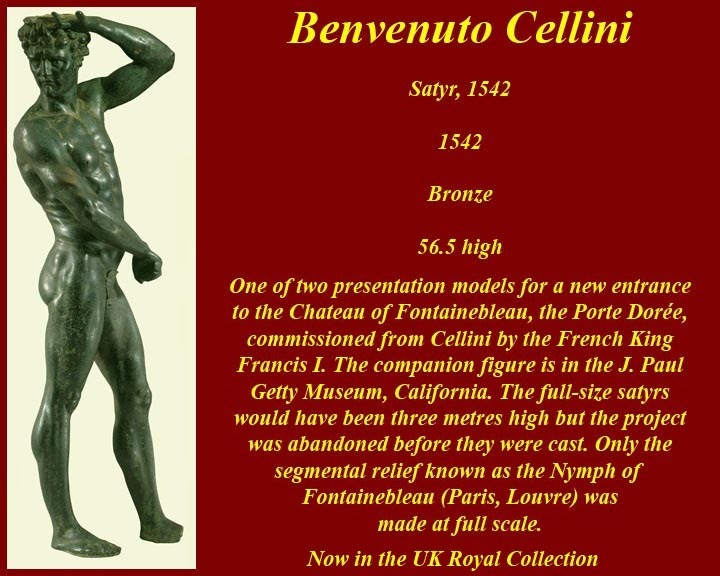
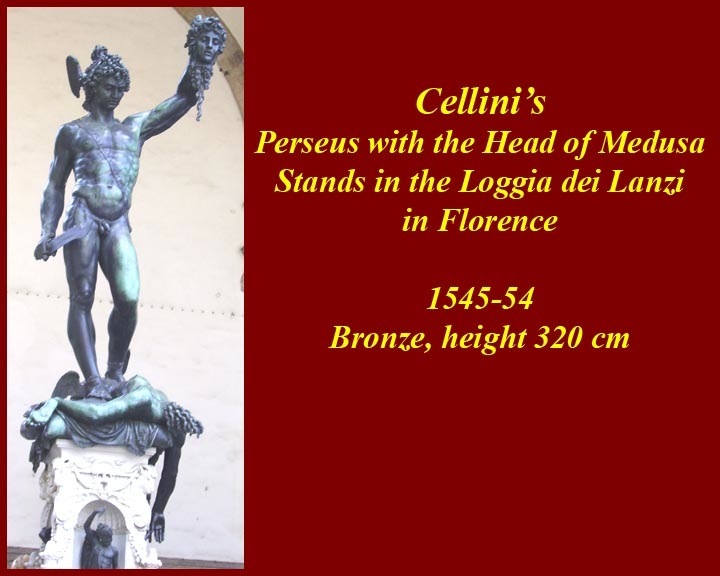
http://www.mmdtkw.org/RenRom0715c-Satyr1542.jpeg
http://www.mmdtkw.org/RenRom0715d-PerseusMedusaLoggiaLanzi.jpg
http://www.mmdtkw.org/RenRom0715e-HermesBargello.jpg
http://www.mmdtkw.org/RenRom0715f-CelliniAutobiography.jpg
Benvenuto Cellini was a sociopath. He was a braggart, a liar, a thief, and, by his own account, a serial murderer. He only managed to escape the headsman's axe because of his talent as a metalsmith and his ability to flatter various cardinals, popes, and monarchs with commemorative medals, coins, and statues. His patrons probably saw something of themselves in him.
In his own time his greatest reputation was as a goldsmith (aside from his criminal reputation), but only one of his works in gold has survived, the celebrated gold, enamel, and ivory salt-cellar (known as la Saliera) made for Francis I of France in 1543. In 2000, this piece was stolen from its glass case at the the Vienna Art History Museum, but, surprisingly, it was recovered undamaged in 2006.
Three of Cellini's bronzes are shown. Because multiple authorized copies in multiple sizes were cast by Cellini and by foundries that he used, and because even more unauthorized fakes were made later, there is a flourishing market for these and other Cellini statues. There are usually several "authentic" and "signed" Cellinis available in on-line sales; caveat emptor.
Cellini and the defense of Castel Sant'Angelo: Benvenuto Cellini, Florentine goldsmith, talented sculptor, and insufferable braggart, happened to be on hand during the defense of Castel Sant'Angelo after the landsknechts of Charles V occupied and sacked Rome in 1527. He wrote about the ensuing battle in his swashbucklingly entertaining Autobiography. If he's to be believed, Cellini single-handedly saved the Pope Clement VII de' Medici, the castle, and indeed the city of Rome itself, taking control of the cannon and firing away when he saw that the Roman bombardiers, fearful they might hit their own homes, were cowering and sobbing. If his autobiography is to be believed, he also used a harquebus to shoot landesknecht's commander, the Constable of Bourbon (Charles III of Montpensier, Duke of Bourbon and Auvergne, Count of Clermont-en-Beauvaisis, Forez and La Marche, and Lord of Beaujeu) , in one attack and later killing Philibert, Prince of Orange, as well.
Several versions of the Autobiography of Benvenuto Cellini, which he began to write in 1558, are available on the Internet. Hector Berlioz wrote an opera loosely based on the Autobiograph. The video recording of the opera is very strange.
For information on Cellini, see http://en.wikipedia.org/wiki/Benvenuto_Cellini and http://www.visual-arts-cork.com/sculpture/benvenuto-cellini.htm and http://www.nndb.com/people/909/000084657/ and http://www.ecatholic2000.com/cathopedia/vol3/volthree464.shtml.
For Cellini's works, see http://www.artcyclopedia.com/artists/cellini_benvenuto.html and http://www.wga.hu/frames-e.html?/html/c/cellini/.
Annibale Carracci (November 3, 1560 - July 15, 1609)
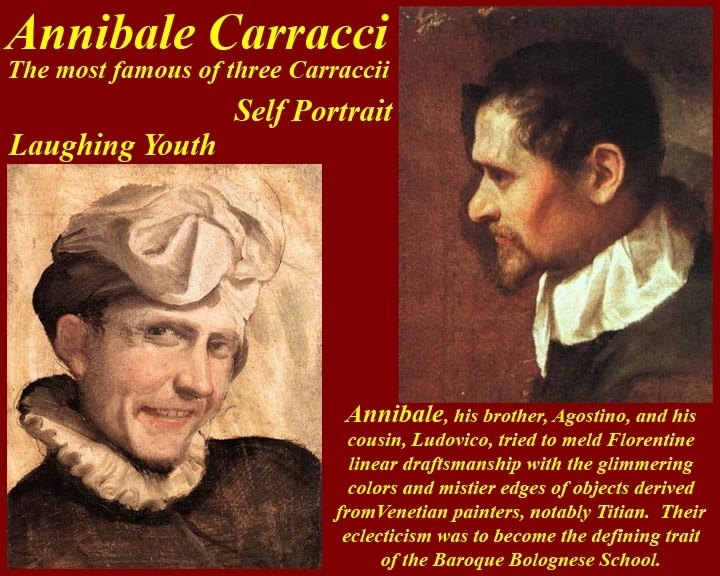
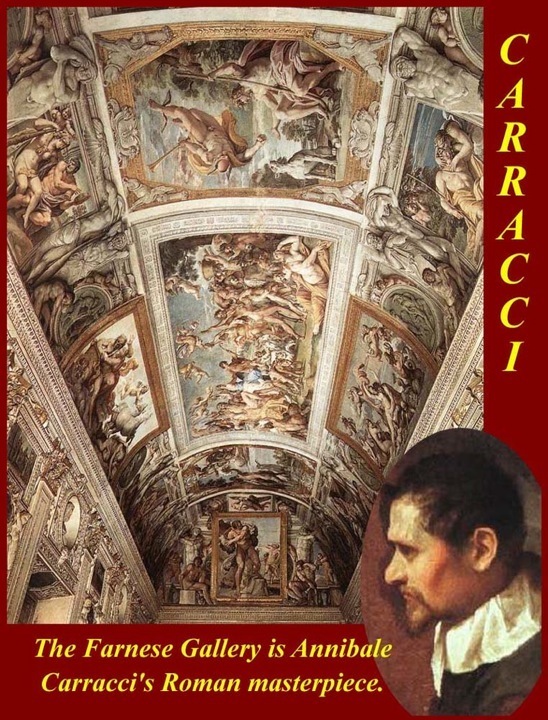
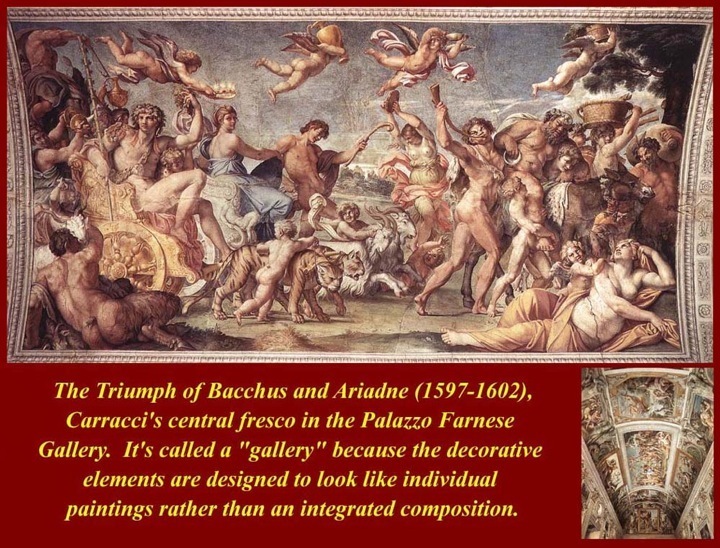
http://www.mmdtkw.org/RenRom0716-CarracciSelf.jpg
http://www.mmdtkw.org/RenRom0717-CarracciFarnese.jpg
http://www.mmdtkw.org/RenRom0717a-CarracciBacchus.jpg
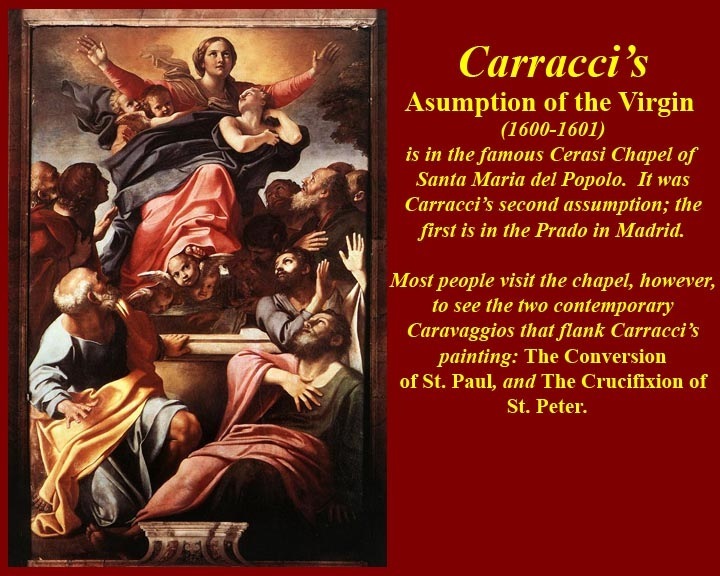
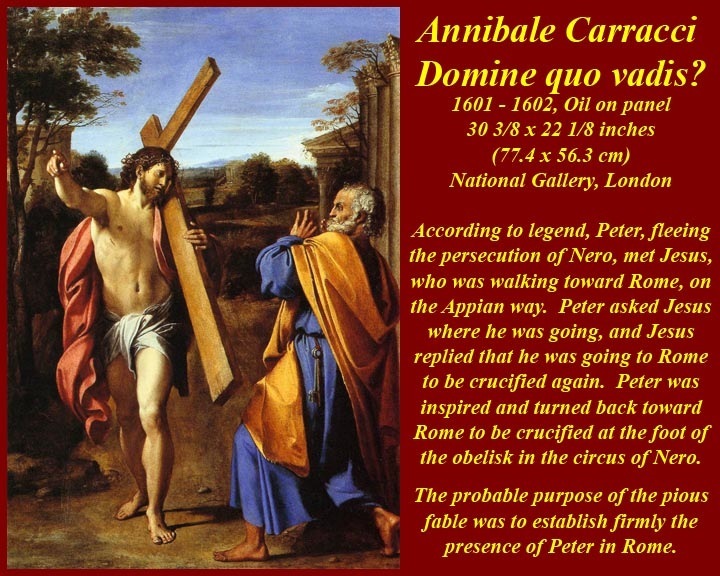
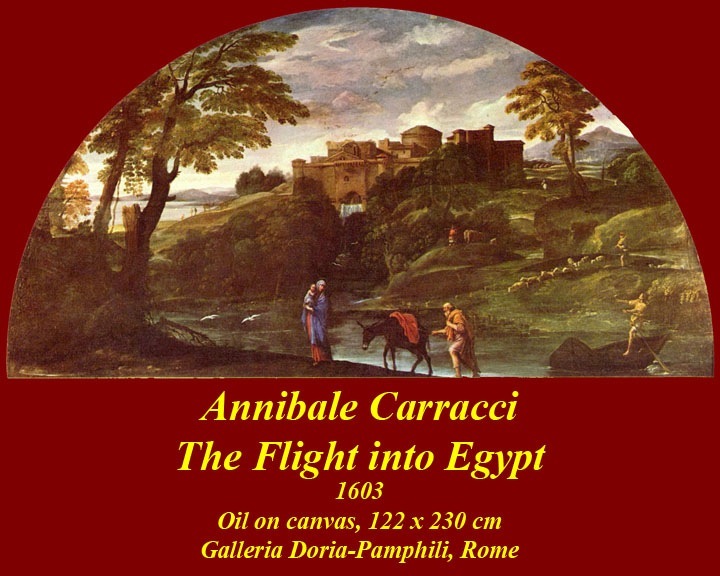
http://www.mmdtkw.org/RenRom0717b-Carracci-AssumptionPopolo.jpg
http://www.mmdtkw.org/RenRom0717c-CarracciQuoVadis.jpg
http://www.mmdtkw.org/RenRom0717d-FlightEgypt1603DoriaPamphili.jpg
http://www.mmdtkw.org/RenRom0717e-RiverLandscapeUSNatGallery.jpg
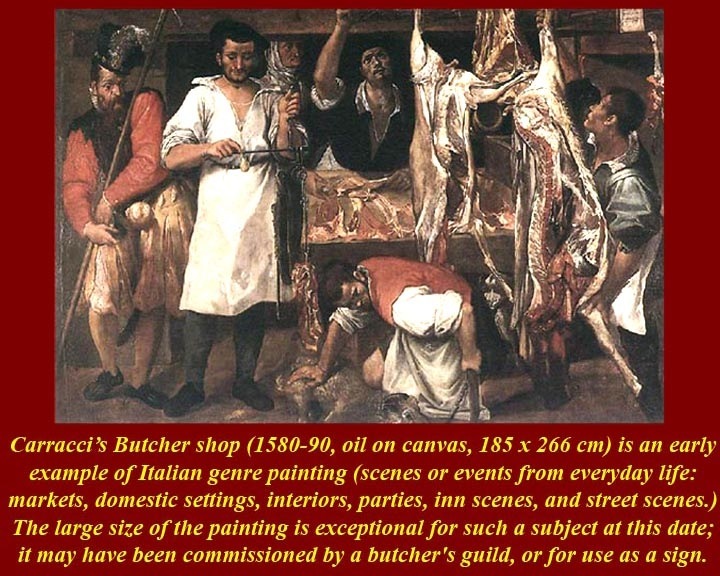
http://www.mmdtkw.org/RenRom0717f-CarracciButcherShop.jpg
http://www.mmdtkw.org/RenRom0717g-AnnibaleCarracciBeaneaterGalColonna.jpg
Annibale Carracci and his brother Agostina and his cousin Ludovico Carracci opened a painters' studio, initially called by some the Academy of the Desiderosi (desirous of fame and learning) and subsequently the Incamminati (progressives; literally "of those opening a new way"). While the Carraccis laid emphasis on the typically Florentine linear draftsmanship, as exemplified by Raphael and Andrea del Sarto, their interest in the glimmering colors and mistier edges of objects derived from the Venetian painters, notably the works of Venetian Oil Painter Titian. This eclecticism was to become the defining trait of the artists of the Baroque Emilian or Bolognese School. Based on the prolific and masterful frescoes by the Carracci in Bologna, Annibale was recommended to Cardinal Odoardo Farnese, who wished to decorate the piano nobile of the cavernous Roman Palazzo Farnese.
In November-December of 1595, Annibale and Agostino traveled to Rome to begin decorating the Camerino with stories of Hercules, appropriate since the room housed the famous Greco-Roman antique sculpture of the hypermuscular Farnese Hercules. Annibale's Triumph of Bacchus and Ariadne (1597-1602) is the main element of the ceiling he frescoed in the large reception hall of Palazzo Farnese (The room is called the Gallery Farnese because the decorative elements were designed to look like individual paintings rather than an integrated composition).
Some of Annibale's paintings look like standard (if somewhat sparkly) mannerist productions, but he also painted some intriguing scenes putting some landscape elements far into the foreground and placing the light source far behind the plane of the picture -- just as Carravaggio was doing with his paintings of people. The Carraccis were the heirs and transmitters of Mannerism in Rome while Caravaggio and the Caravaggisti spread tenebrismo through Europe (it expired in Rome shortly after Caravagio fled Rome with the police in pursuit).
Annibale Carracci also pioneered a style which would come to be called "genre painting", the realistic portrayal of scenes and events from everyday life and with common people. Two of Annibale's archetypical genre paintings are shown. The Bean Eater is another of Annibale's self portraits.
For more information on Annibale Carracci, see http://www.metmuseum.org/TOAH/hd/carr/hd_carr.htm and http://en.wikipedia.org/wiki/Annibale_Carracci and http://www.wga.hu/frames-e.html?/bio/c/carracci/annibale/biograph.html.
For Annibale's paintings and frescoes, see http://www.artcyclopedia.com/artists/carracci_annibale.html and http://www.wga.hu/frames-e.html?/html/c/carracci/annibale/index.html and http://commons.wikimedia.org/wiki/Category:Annibale_Carracci.
Caravaggio (Michelangelo Merisi), (29 September 1571–18 July 1610)
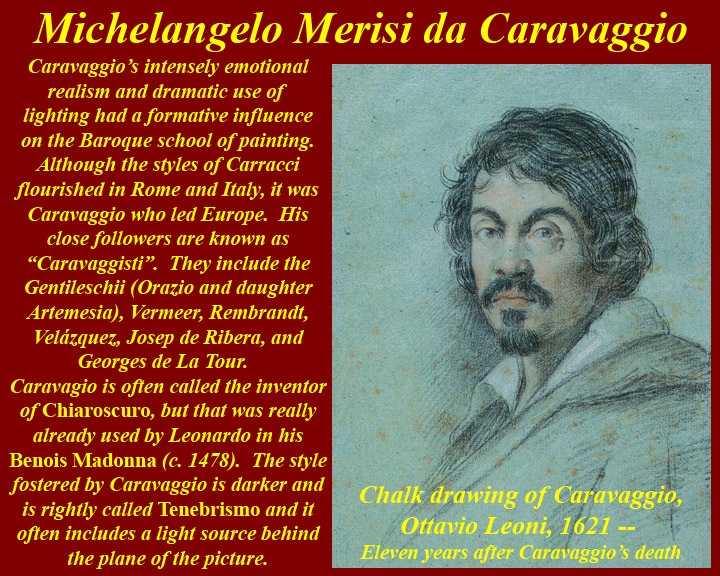
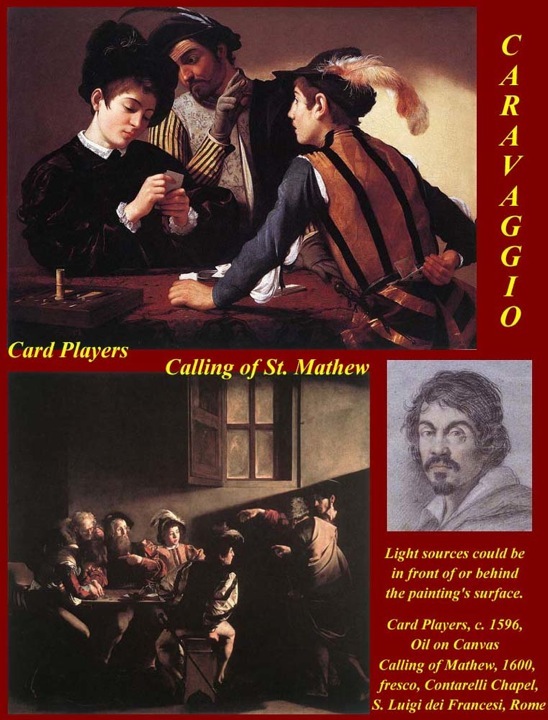
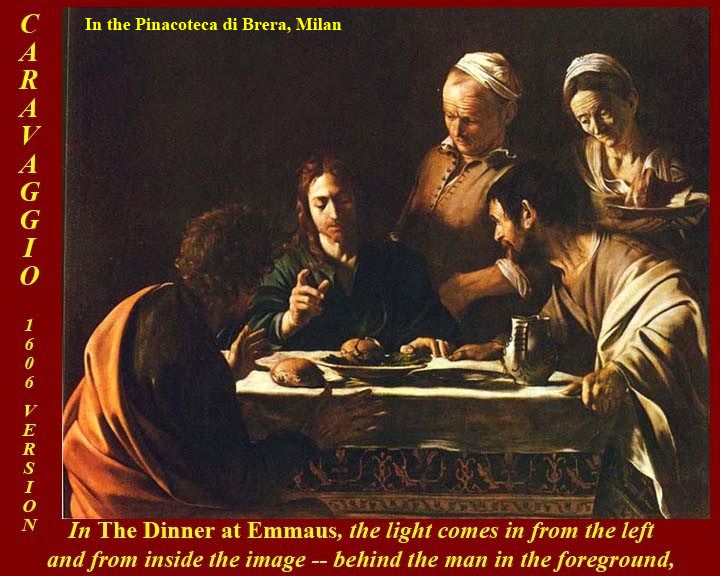
http://www.mmdtkw.org/RenRom0718-1OttavioLeoniCaravaggio1621.jpg
http://www.mmdtkw.org/RenRom0718-2CaravCardsMathew.jpg
http://www.mmdtkw.org/RenRom0718-3CaravaggioEmmaus1606.jpg
http://www.mmdtkw.org/RenRom0718a-CaravaggioSacrificeIsaac1603.jpg
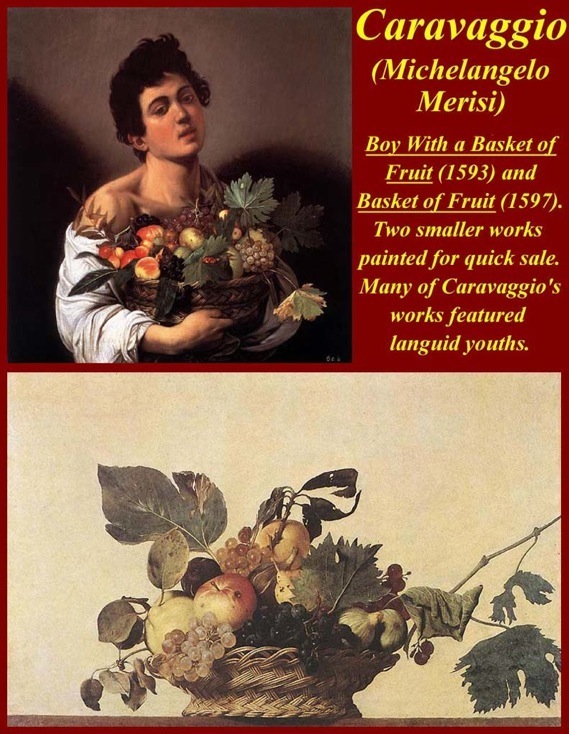
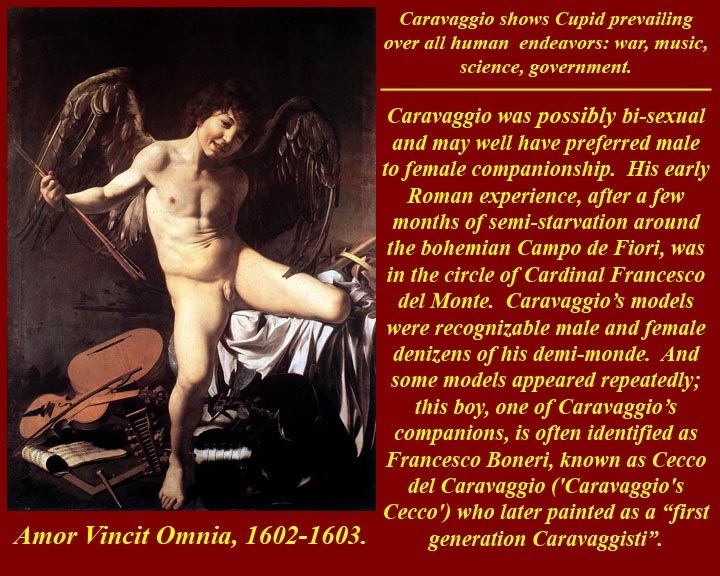
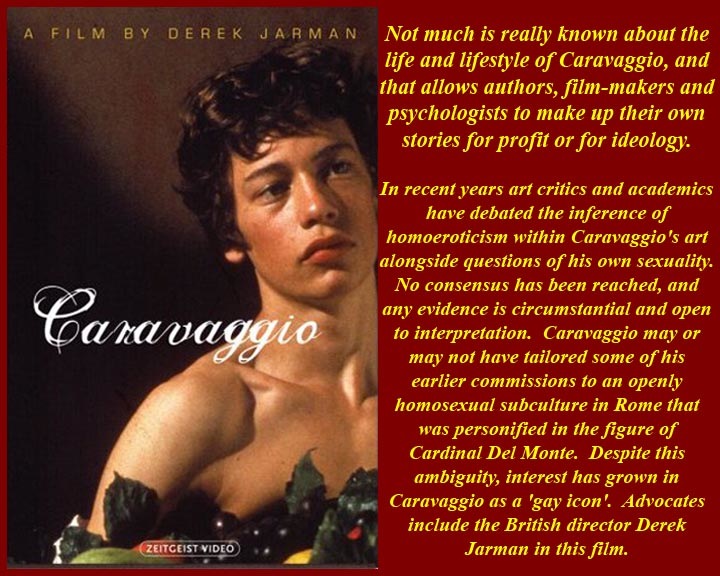
http://www.mmdtkw.org/RenRom0718b-CaravaggBoyFruit.jpg
http://www.mmdtkw.org/RenRom0718c-AmorVictorious.jpg
http://www.mmdtkw.org/RenRom0718c1-CaravaggioJarmanFilm.jpg
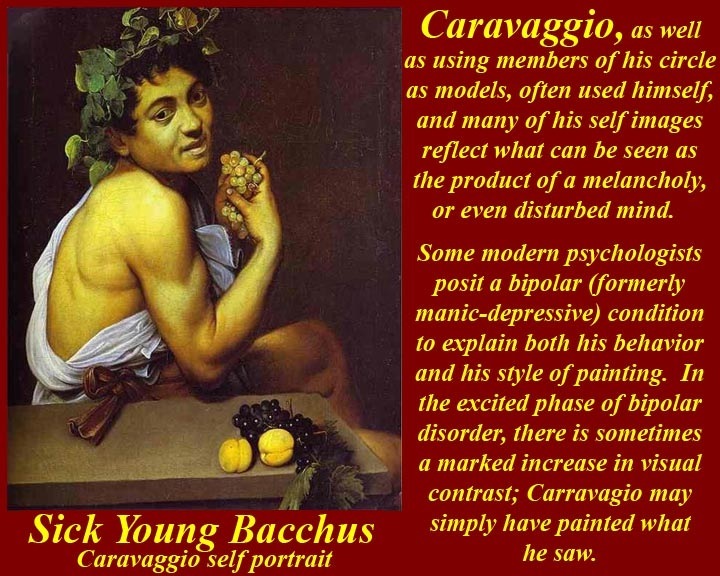
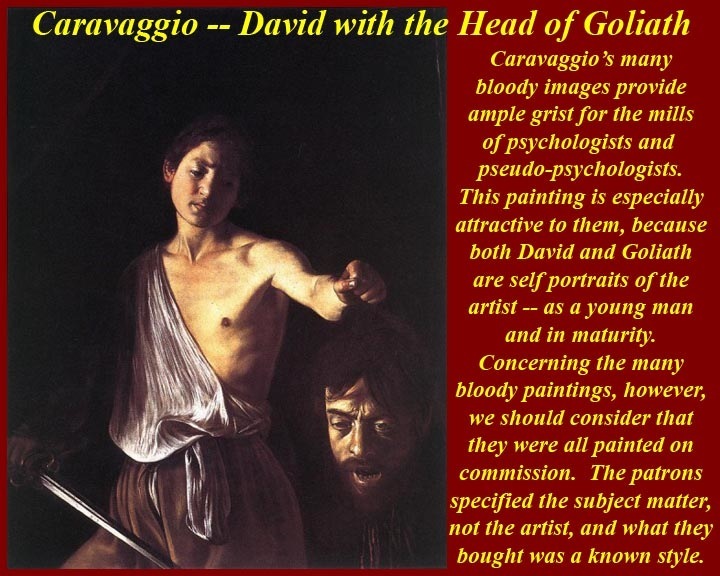
http://www.mmdtkw.org/RenRom0718d-CaravaggioBacchus-self.jpg
http://www.mmdtkw.org/RenRom0718e-CarravaggioBothDavidAndGoliath.jpg
http://www.mmdtkw.org/RenRom0720-CaravaggioCrucifixionConversionSMPopolo1601.jpg
Caravaggio just couldn't stay out of trouble. When he came to Rome in 1592 he settled uneasily into the "artist's life" of drinking, brawling, and starving in the colony of similar men (and their molls) around Campo de Fiori. An early published notice on him, dating from 1604 and describing his lifestyle three years previously, tells how "after a fortnight's work he will swagger about for a month or two with a sword at his side and a servant following him, from one ball-court to the next, ever ready to engage in a fight or an argument, so that it is most awkward to get along with him". Caravaggio seemed to fancy himself as a "bravo" of the kind that Shakespeare parodied in the very first scene of Romeo and Juliet -- but most of that type were either killed or grew out of it. Caravaggio continued to be a bravo for all of his short 39 year life.
In his earliest Roman years Caravaggio eked out a living by painting small still lifes and small paintings of street boys to be sold on the Campo. Nobody knows if Caravaggio patronized the boys himself or if he merely painted them to sell to the homosexuals who frequented the area. He then worked as an assistant in a number of studios, but never stayed in any one very long -- his bad reputation and quarrelsomeness didn't work in his favor. Somebody needed to take the young man in hand. In 1595, he decided to set out on his own and began to sell his pictures through a dealer, a certain Maestro Valentino, who brought Caravaggio's work to the attention of Cardinal Francesco del Monte, a prelate of great influence in the papal court. Caravaggio soon came under the protection of Del Monte and was invited to receive board, lodging, and a pension in the house of the cardinal. The cardinal "kept" several young men, and rumors of his own homosexuality abounded. Again, we don't know whether Caravaggio (or the good cardinal) really participated in that lifestyle -- it's still argued vigorously on the Internet as some members of the gay community tries to claim both men as celebrity members of their fraternity and others try to deny it.
Caravaggio is often considered to be the father of the tenebroso or tenebrismo style of exaggerated chiaroscuro painting. One of the characteristics of Caravaggio's tenebrism is placing the pictures light source behind the plane of the painting. This meant that some of his human subjects might be "back lighted", i.e., the side of of the subject facing the viewer of the picture is in the darke and the side away from the viewer is lighted. See the examples in the first row of images above.
Caravaggio's personality has been described as melancholy, depressed, disturbed, or manic-depressive (or to be more politically correct, suffering from bipolar disorder); both his behavior and his paintings are cited as evidence. His behavior is documented in accounts of contemporary colleagues, friends, former friends, and enemies -- and on police blotters from Milan to Sicily and Malta. Now envy, fear, bias, and anger may color some of these accounts -- we have no way of really knowing -- but there does appear to be a pattern of bad behavior here. Regardless of what we can gather from accounts of his behavior and personality, we still do have his paintings. They are, as the psychologists say, loaded with clues. There are, in particular, many self portraits that show him ill, drunk, decapitated, decapitating. Two examples are shown. Some psychologists see his tenebrismo as a sign of bipolar disorder; one of the symptoms in the "active" (formerly "manic") phase of bipolar disorder is, according to some psychologists, is a change in visual acuity and perceived visible contrast levels. Their argument seems to be that Caravaggio's vision was "different" and so he saw differently and he painted what he saw (which was different from what other people saw) and therefore he was different. There is a distressing circularity here, which is often the case in psychology and that's distressing, if you want to get circular.
In the section on Carracci above it is mentioned that people go to the Cerasi Chapel in Santa Maria del Popolo church to see the Caravaggios rather than the Carracci Asumption. The two Carravaggios in the chapel are in the last image in this section.
Caravaggio died, possibly of malaria, on the beach at Port Ercole south of Rome on July 18, 1610. He had missed his boat, which was carrying his possessions and most of his paintings that he still owned, after being questioned by the police (for once, mistaken identity). Read about it in one of the bio notes below.
For short bio notes on Caravaggio, see http://en.wikipedia.org/wiki/Caravaggio and http://www.wga.hu/frames-e.html?/bio/c/caravagg/biograph.html and http://www.artchive.com/artchive/C/caravaggio.html.
His paintings can be viewed on the Internet at http://en.wikipedia.org/wiki/Chronology_of_works_by_Caravaggio and http://caravaggio.com/# and http://www.christusrex.org/www2/art/caravaggio.htm.
Orazio Lomi Gentileschi (1563 - 1639) and his daughter,
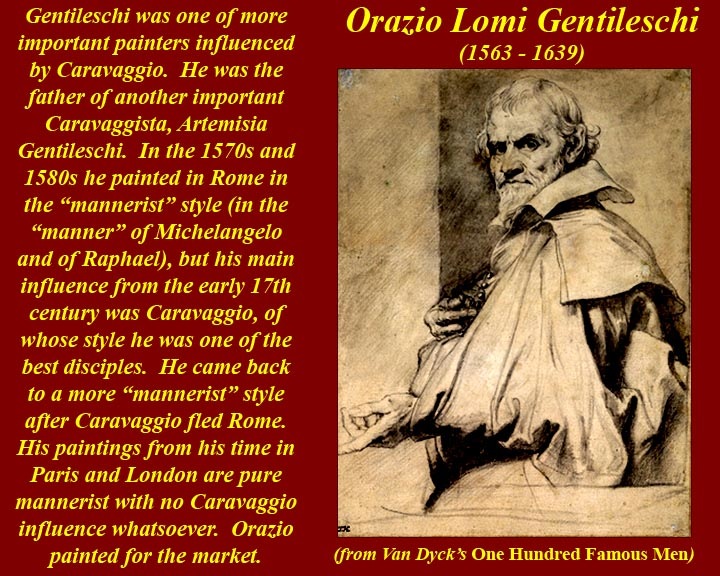
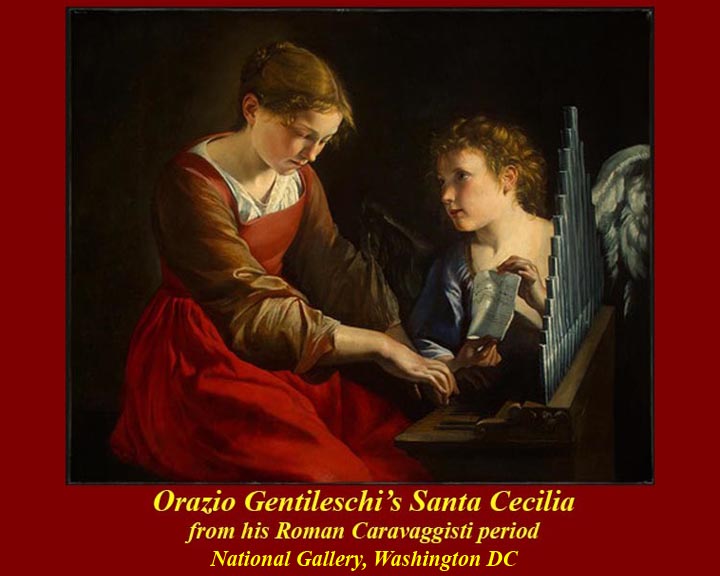
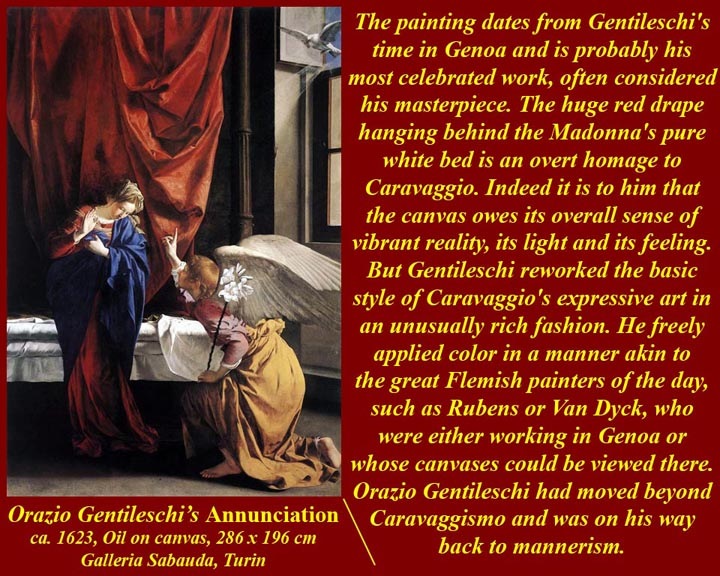
http://www.mmdtkw.org/RenRom0720a-OrazioGentileschi.jpg
http://www.mmdtkw.org/RenRom0720b-OrazioGentileschiStCecilia.jpg
http://www.mmdtkw.org/RenRom0720c-OrazioGentileschiAnnunciation.jpeg
http://www.mmdtkw.org/RenRom0720d-GentileschiPeaceTheArts_c1638-9.jpg
Artemisia Gentileschi (July 8, 1593–ca. 1656)
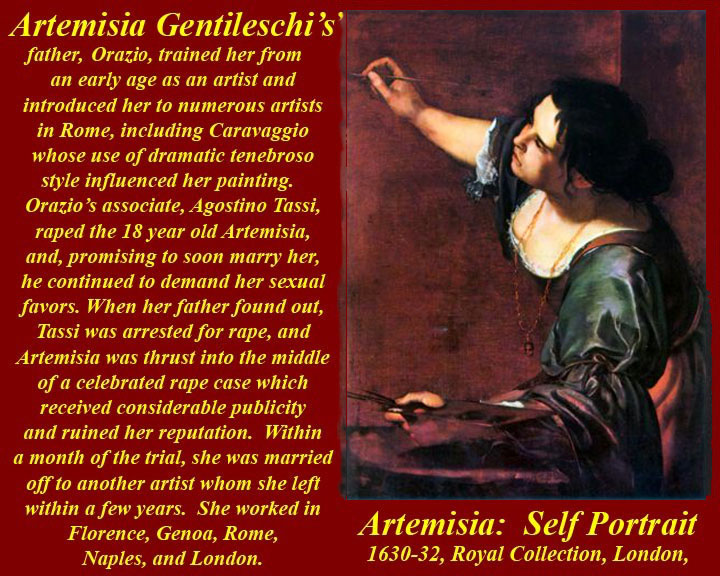
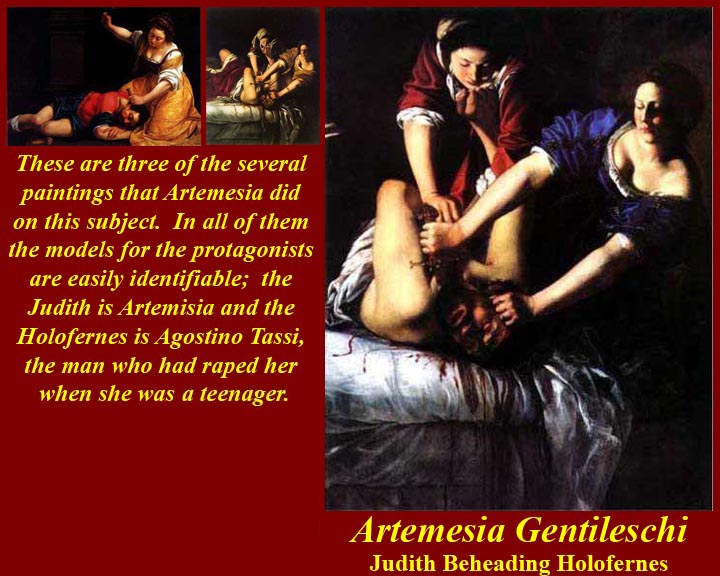
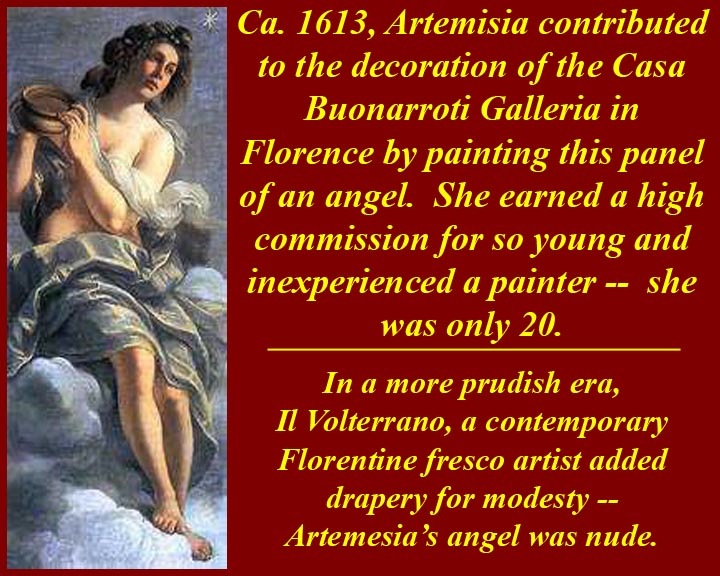
http://www.mmdtkw.org/RenRom0720e-ArtemisiaSelfP.jpg
http://www.mmdtkw.org/RenRom0720f-ArtemisiaJudithCapodimonte.jpg
http://www.mmdtkw.org/RenRom0720g-ArtemisiaAngel.jpg
http://www.mmdtkw.org/RenRom0720hArtemisiaMovie.jpg
Orazio Gentileschi and his daughter Artemisia were two of the most able "first generation" Caravaggisti, e.g., followers of Caravaggio's painting style, who lived at the same time that Caravaggio did and who (usually) actually knew the painter.
In the late 1570s or early 1580s Orazio Gentileschi moved to Rome, and was associated with the landscape-painter Agostino Tassi, executing the figures for the landscape backgrounds of this artist in the Palazzo Rospigliosi, and it is said in the great hall of the Quirinal Palace, although by some authorities the figures in the last-named building are ascribed to Giovanni Lanfranco. He worked also in the churches of Santa Maria Maggiore, San Nicola in Carcere, Santa Maria della Pace and San Giovanni in Laterano. This work was firmly in the mannerist tradition, which emulated the styles of Michelangelo and Raphael. Orazio's daughter Artemisia was born in Rome in 1593.
However, Orazio's main artistic influence starting from the early 17th century was Caravaggio, also in Rome at the time, of whose style he was one of the best followers. He took part in several of Caravaggio's misadventures in Rome's streets, and in 1603 he was called as a witness in the proceedings against Caravaggio.
In 1612 Orazio was again called to the Tribunal of Rome, this time to speak against Tassi, charged with the rape of his daughter Artemisia Gentileschi.
After Caravaggio's flight from Rome, Gentileschi developed a more personal Tuscan lyricism, characterized by lighter colors and precision in detail, reminiscent of his Mannerist beginnings. After a long sojourn in the Marche, in the early 1620s Gentileschi went to Genoa, and then to Paris, at the court of Marie de Medici.
In 1626 he left France to work for Charles I of England, where he remained for the rest of his life. His works became increasingly conventional and decorative, but were appreciated by the local aristocracy for their classicism. Van Dyck included Orazio (above) in his portrait drawings of one hundred illustrious men.
Orazio Gentileschi died in 1639 in London.
Artemisia Gentileschi, Orazio's daughter, is today considered one of the most accomplished painters in the generation influenced by Caravaggio. In an era when women painters were not easily accepted by the artistic community, she was the first female painter to become a member of the Accademia di Arte del Disegno in Florence.
She was one of the first female artists to paint historical and religious paintings, at a time when such heroic themes were considered beyond a woman's reach.
Artemisia Gentileschi was born in Rome, July 8, 1593, the first child of the Tuscan painter Orazio Gentileschi. Her mother died when Artemisia was twelve and Artemisia was was raised by her father, who introduced her to painting in his workshop. She showed much more talent than her brothers, who worked alongside her and excelled in drawing, mixing color, and painting. Since her father's style took inspiration from Caravaggio during that period, her style was just as heavily influenced in the same direction. But her approach to subject matter was different from her father's, as her paintings are highly naturalistic, where Orazio's are idealized.
Because, as a woman, she was denied access to the artistic academies, her father hired Tassi to instruct her. Tassi, with the help of a friend, raped Artemisia and then coopted her into a continuing sexual relationship by promising to marry her. When it became obvious that Tassi marriage promise was false, Artemisia's father prosecuted Tassi for rape (and for theft of a painting) in 1613. In the seven month trial , which centered on the rape, Tassi denied the charges and tried to destroy her reputation, but he was convicted after it was shown that he also had planned to murder his wife, had engaged in a sexual affair with his sister-in-law (who testified against him), and had planned to steal several paintings from Orazio. Artemisia was tortured during her testimony against Tassi -- on the theory that testimony under torture was more likely to be true than simple testimony.
After the trial, Artemisia was quickly married off to a Florentine artist, and the couple moved to Florence where they had five children. Artemisia was a great artistic success in Florence where she was the first woman accepted into the Accademia delle Arti del Disegno (Academy of the Arts of Drawing). Despite her success, monetary problems prompted a move back to Rome in 1621. This was the start of a peripatetic life during which she shed her husband, had a daughter out of wedlock, and, at some point, rejoined her father. The painting styles of Orazio and Artemisia gradually merged to the point that it is difficult to discriminate and ascribe their works. One identifying characteristic of Artemisia's paintings, many of which illustrate the bloody demise of villains, is her inclusion of images of Tassi as the villain and herself as the woman who killed him.
During their travels, which included cities in Italy and then Paris and London, the styles of father and daughter gradually shifted from Caravaggisti back to mannerism, but it is not known whether that was their decision or that of their patrons and commissioners -- like most artists they would have been greatly influenced by their market.
Orazio suddenly died in 1639. Artemisia had her own commissions to fulfill after her father's death, although there are no known works assignable with certainty to this period. It is known that Artemisia had already left England by 1642, when the civil war was just starting. Nothing much is known about her subsequent movements. Historians know that in 1649 she was in Naples again, corresponding with Don Antonio Ruffo of Sicily who became her mentor during this, her second, Neapolitan period. The last known letter to Ruffo is dated 1650 and makes clear that she was still fully active. Artemisia was once thought to have died in 1652/1653. Recent evidence, however, has shown that she was still accepting commissions in 1654 -- though she was apparently increasingly dependent on her assistant, Onofrio Palumbo. Thus it might be speculated that she died in the devastating plague that swept Naples in 1656 and virtually wiped out an entire generation of Neapolitan artists.
The 1997 film Artemisia, directed by Agnès Merlet is full if blatant falsehoods. It is loosely based on the painter's life, but its portrayal of the relationship between Agostino Tassi and Artemisia Gentileschi as a passionate affair rather than as rape is wildly inaccurate. It also shows Artemisia denying under torture that she had been raped and Tassi chivalrously taking the blame for the affair -- precisely the opposite of what the trial documents show.
An important international exhibition of the works of Orazio and Artemisia Gentileschi was held at the Metropolitan Museum of Art in New York in 2002. Two works by Orazio are in the Washington DC National Gallery.
Biographic information on Orazio Gentileschi is on the Internet at http://en.wikipedia.org/wiki/Orazio_Gentileschi and http://www.artcyclopedia.com/artists/gentileschi_orazio.html. His art can be viewed at http://www.wga.hu/frames-e.html?/html/g/gentiles/orazio/index.html
Biographic information on Artemisia is available at http://www.artemisia-gentileschi.com/index.shtml and http://en.wikipedia.org/wiki/Artemisia_Gentileschi. Her works can be seen at http://www.artemisia-gentileschi.com/index.shtml and at http://www.svreeland.com/image-gal.html and http://www.arthistoryarchive.com/arthistory/baroque/Artemisia-Gentileschi.html.
Guido Reni (4 November 1575 – 18 August 1642)
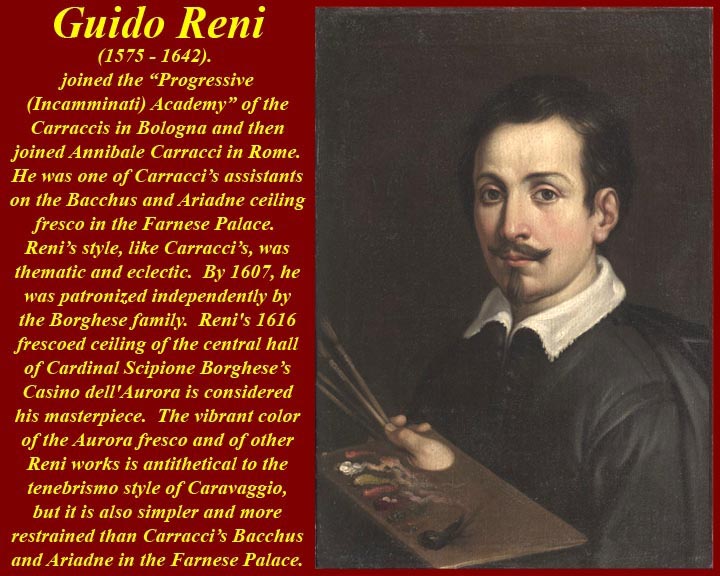
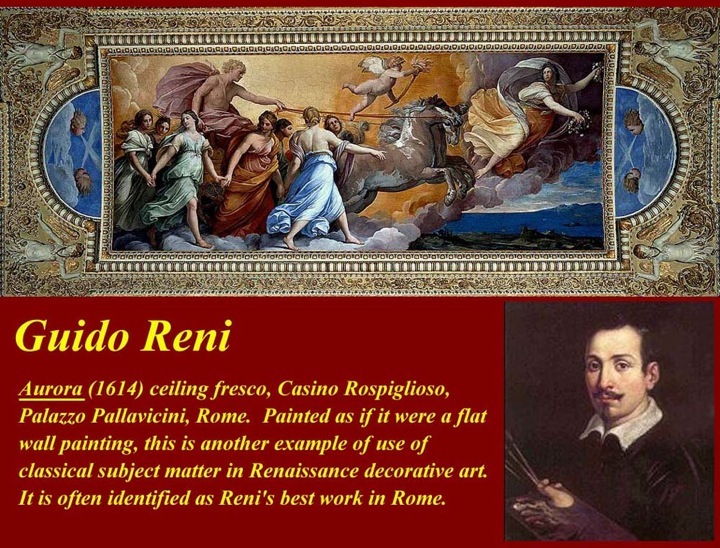
http://www.mmdtkw.org/RenRom0721-Renisp.jpg
http://www.mmdtkw.org/RenRom0721a-ReniAurora.jpg
http://www.mmdtkw.org/RenRom0722-ReniMichael.jpg
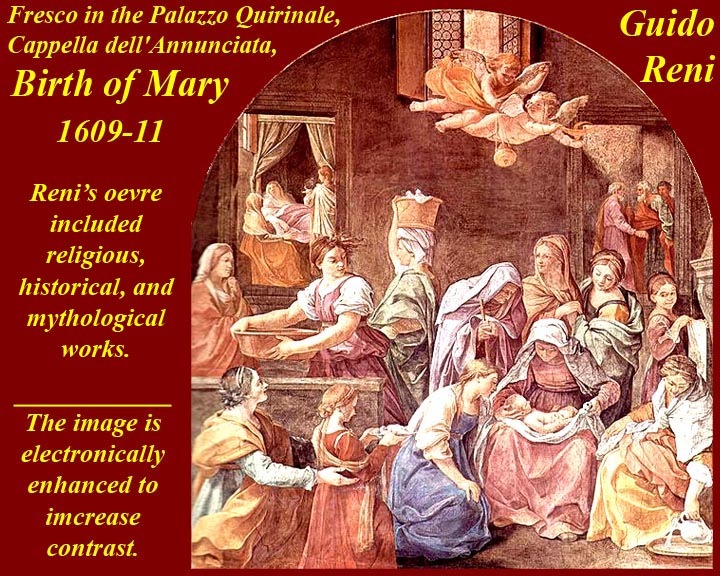
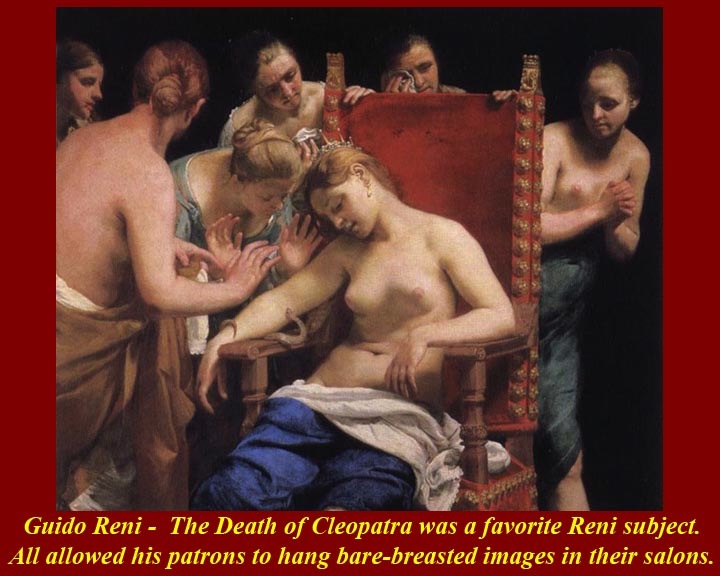
http://www.mmdtkw.org/RenRom0722a-ReniBirthMaryQuirinale.jpg
http://www.mmdtkw.org/RenRom0722b-ReniCleopatra.jpg
http://www.mmdtkw.org/RenRom0722c-ReniAbductionDeianira1621.jpg
Guido Reni was born in Bologna into a family of musicians. After a Bolognese apprenticeship he moved to Rome to work with the teams led by Annibale Carracci in fresco decoration of the Farnese Palace. He quickly acquired a patron and by 1604 he had his first independent commission. From 1607-1614, he was one of the painters patronized by the Borghese family. Reni was soon at work on the frescoed ceiling of the large central hall of the garden reception building of Cardinal Scipione Borghese, now known as the Casino dell'Aurora and located in what are now the grounds of the Palazzo Pallavicini-Rospigliosi. The large central picture in the ceiling, cumbersomely entitled Apollo in his Chariot Preceded by Dawn [Aurora] Bringing Light to the World, is considered Reni's masterpiece. It shows far more simplicity and restraint than Carracci's riotous Triumph of Bacchus and Ariadne in the Farnese. There is little concession to perspective, and the vibrantly colored style is antithetical to the tenebrism of Caravaggio's followers. Reni, like the Carracci's carried the mannerist tradition in Rome while Caravaggio's tenebrismo inspired artists elsewhere in Europe. His subject matter was almost entirely religious and ancient mythological. After a short sojourn in Naples (where he was harassed by jealous local artists), he returned to a successful career in Bologna where he died in 1642.
See http://en.wikipedia.org/wiki/Guido_Reni for bio information and for his art see http://www.artcyclopedia.com/artists/reni_guido.html. The US National Gallery of Art has four of his etchings and one chalk drawing; see http://www.nga.gov/cgi-bin/tsearch?oldartistid=203750&imageset=1
Gian Lorenzo Bernini; 7 December 1598 — 28 November 1680)
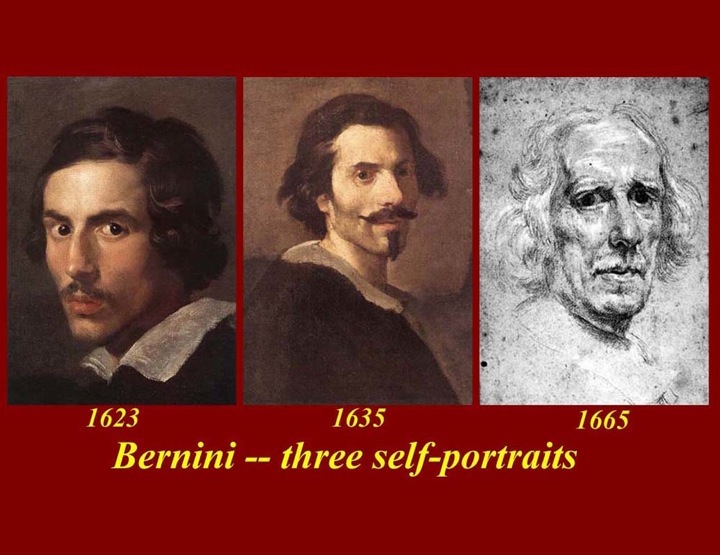
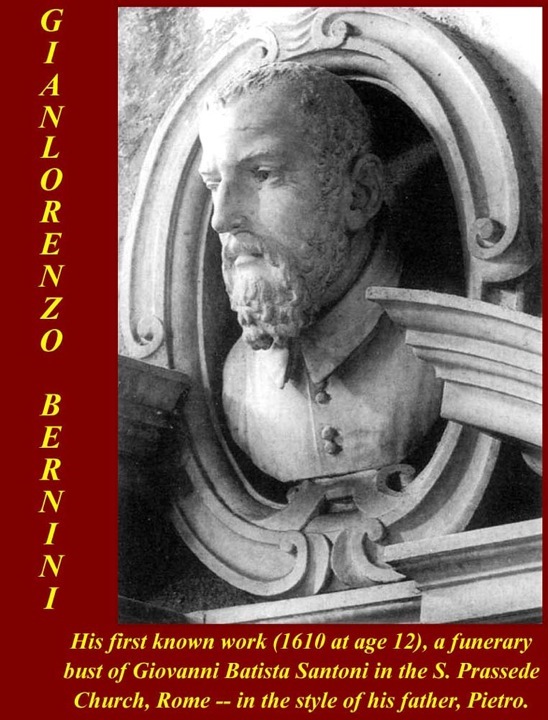
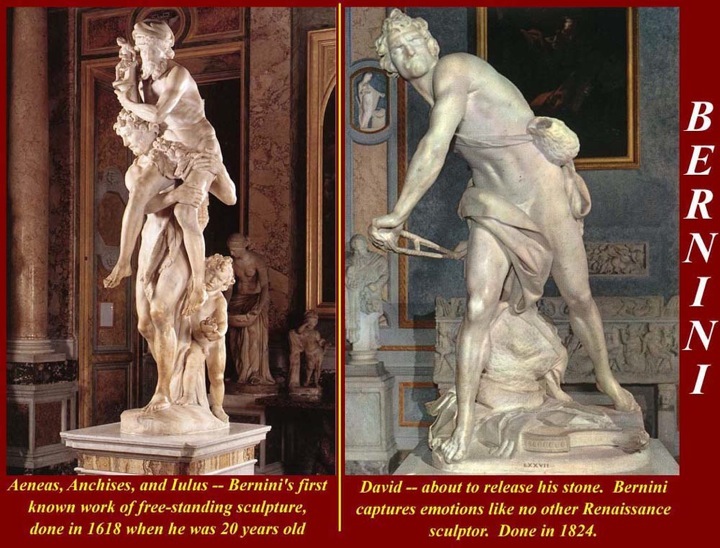
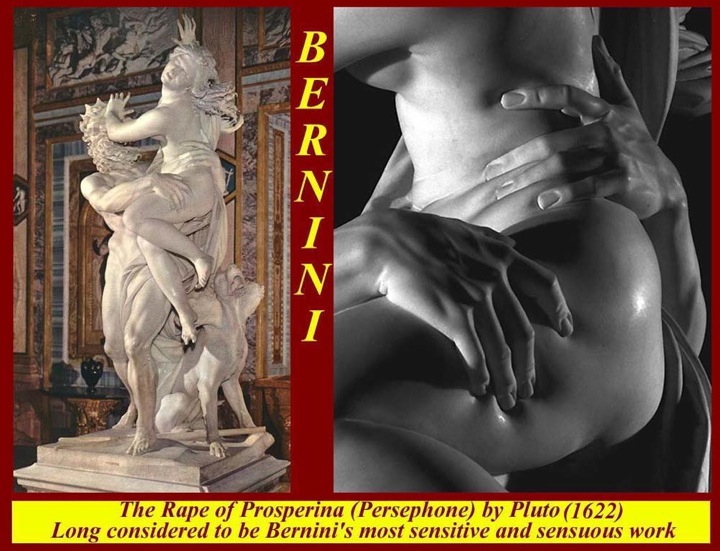
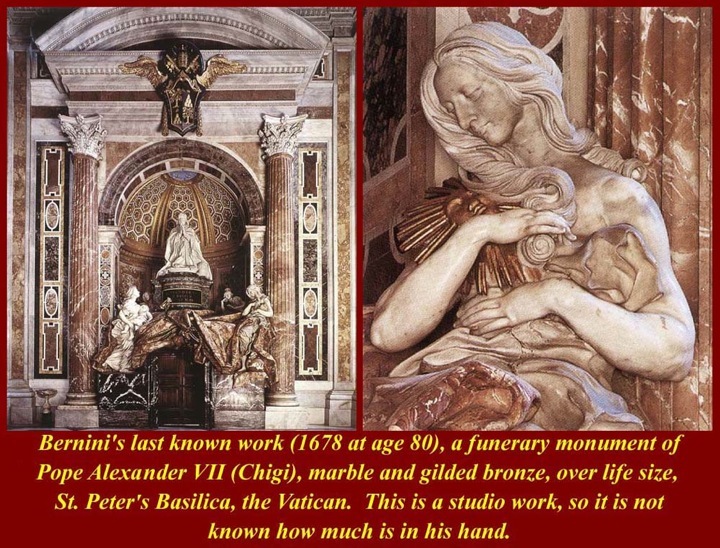
http://www.mmdtkw.org/RenRom0723-BerniniSelfPorts.jpg
http://www.mmdtkw.org/RenRom0724-BerniniFirstWork.jpg
http://www.mmdtkw.org/RenRom0725-BerniniAeneDavid.jpg
http://www.mmdtkw.org/RenRom0726-BerniniProspPlut.jpg
http://www.mmdtkw.org/RenRom0727-BerniniLastWork.jpg
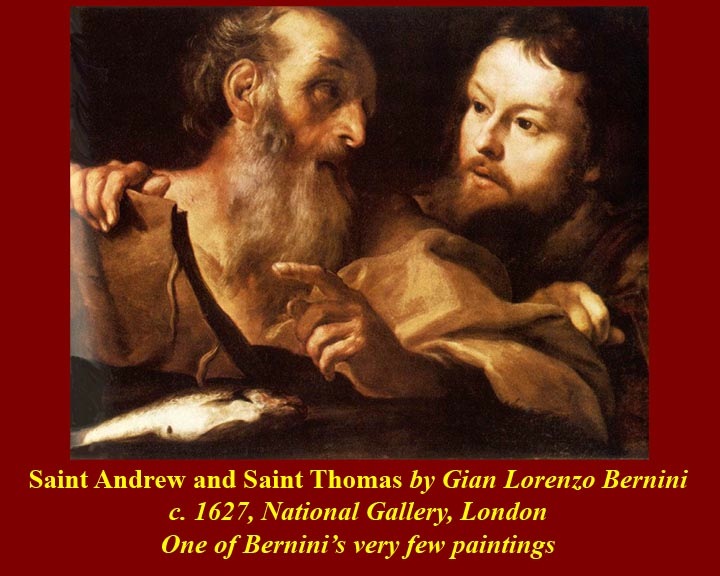
http://www.mmdtkw.org/RenRom0727a-BerniniAndrewThomas.jpg
http://www.mmdtkw.org/RenRom0727b-BerniniApostle.jpg
Bernini worked principally in Rome. He was the leading sculptor of his age and also a prominent architect. In addition he painted, wrote plays, and designed metalwork and stage sets. As a student of Classical sculpture, Bernini possessed the unique ability to capture, in marble, the essence of a narrative moment with a dramatic naturalistic realism which was almost shocking. This ensured that he became the successor of Michelangelo, far outshining other sculptors of his generation. His talent extended beyond the confines of his sculpture to consideration of the setting in which it would be situated; his ability to be able to synthesize sculpture, painting and architecture into a coherent conceptual and visual whole has been termed by the art historian, Irving Lavin, the ‘unity of the visual arts’.
Bernini created the Baroque style of sculpture and developed it to such an extent that other artists are of only minor importance in a discussion of that style. In his long life -- 82 years -- Bernini decorated most of Rome with fountains, buildings, churches, monuments, tombs and excellent marble statuary. Some of his architecture and his rivalry with Borromini were covered in the last unit. His sculptural output began with a funerary portrait head when he was 12 years old and continued for another 68 years when he completed (perhaps only supervising his studio) another tomb. In between there were wonders. His first known full scale free standing statue was of Aeneas carrying his father out of Troy, done in 1618 when he was 20. Four years later, he delivered his David in an extremely tensioned pose about to release the stone that would kill Goliath. Most art historians agree that Bernini carved his own features for the face of David. Both the Aeneas and the David are in the Galleria Borghese in Rome as are four other full scale works, all of which illustrate myths from Ovid's Metamorphoses. The most amazing of the four, the Rape of Prosperina by Pluto, is shown above. Note how Bernini shows the impressions of the fingers of Pluto in the thigh and side of Prosperina.
Only a few of Bernini's paintings are known. He appears only to have painted a few, including his self portraits. It is noteworthy that his Apostle, the last image above, anticipates impressionism by two centuries and is "a brilliant example of Bernini’s ability to render a face with a few confident brushstrokes." The oil sketch is dated by some to the late 1620 and by others to 1655. An further appreciation of Bernini as a painter is in an exhibition review from 2007 in the Art Tribune (at http://www.thearttribune.com/2007-A-Bernini-year-in-Rome.html).
Bio information on Bernini is at http://en.wikipedia.org/wiki/Gian_Lorenzo_Bernini and http://www.artchive.com/artchive/B/bernini.html (which also has links to some of his works including some of his Roman fountains) and http://www.wga.hu/frames-e.html?/bio/b/bernini/gianlore/biograph.html.
Many of his works are also available at http://www.wga.hu/frames-e.html?/bio/b/bernini/gianlore/biograph.html (click on "works") and at http://www.artcyclopedia.com/artists/bernini_gianlorenzo.html.
The national Gallery in Washington DC has two Bernini works, a chalk drawing of a boy and portrait bust of Monsignor Francesco Barberini.
Giovanni Battista Gaulli (May 8, 1639 – April 2, 1709), also known as Baciccio
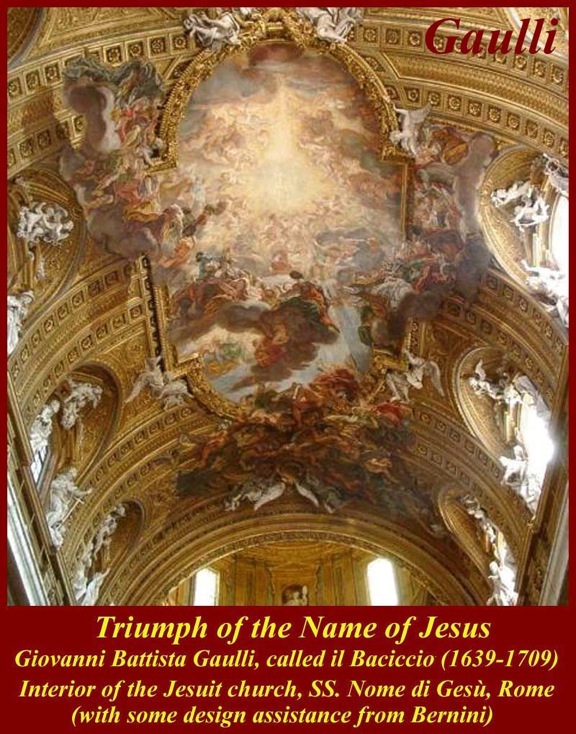
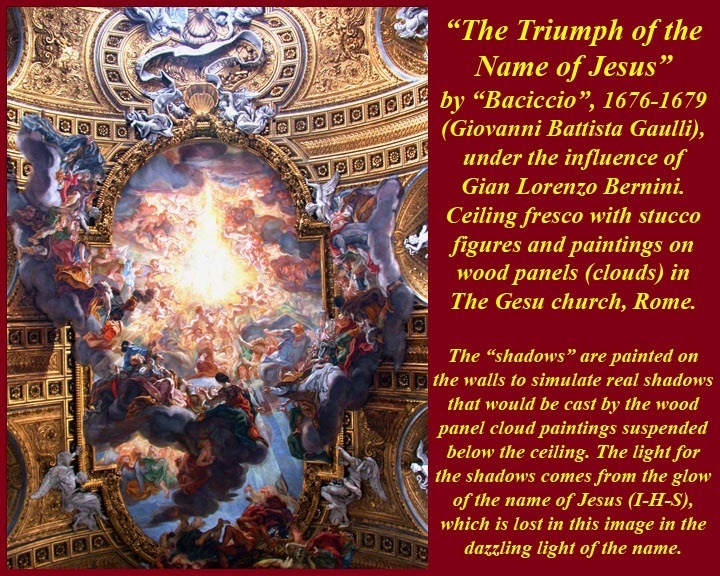
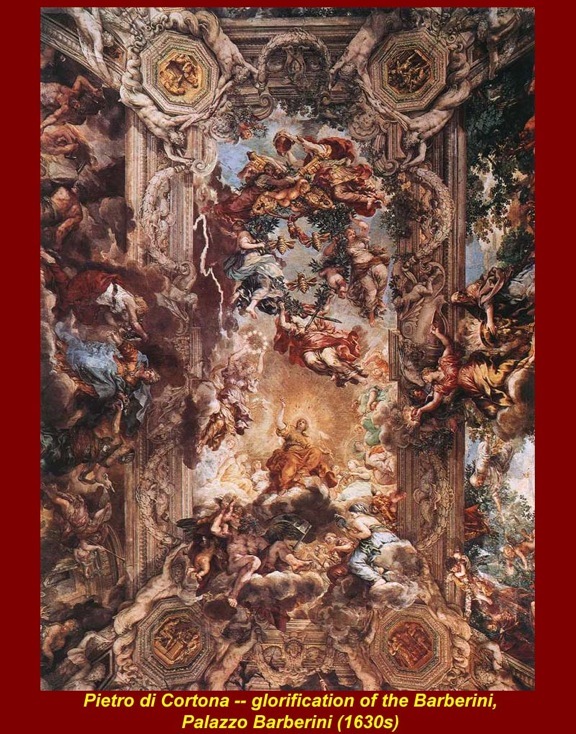
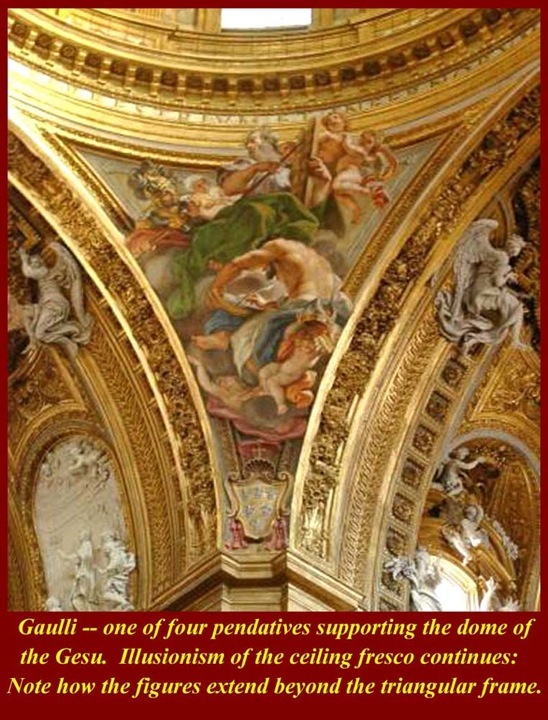
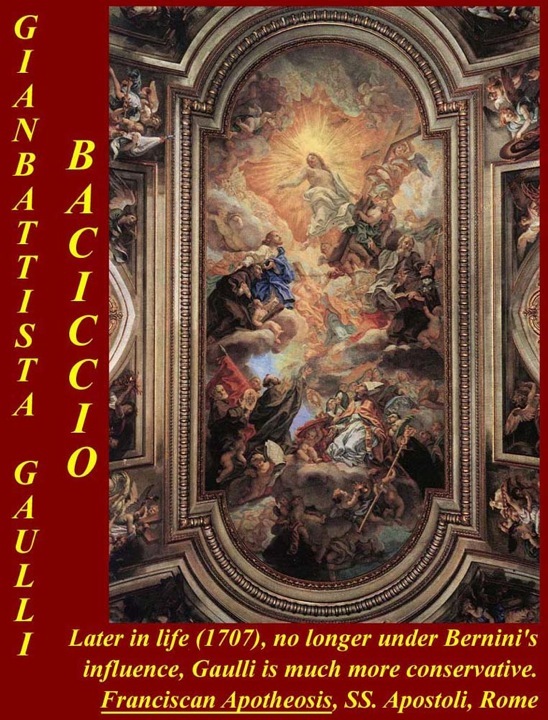
http://www.mmdtkw.org/RenRom0728-GaulliGesuCeil.jpg
http://www.mmdtkw.org/RenRom0728a-NameJesusGaulli.jpg
http://www.mmdtkw.org/RenRom0728b-CortonaBarberi.jpg
http://www.mmdtkw.org/RenRom0729-GaulliPendatGesu.jpg
http://www.mmdtkw.org/RenRom0730-GaulliSApostoli.jpg
http://www.mmdtkw.org/RenRom0731-GaulliJoseph.jpg
Gaulli was from Genoa, an artistic center in those times, and there he saw many different styles of art. He moved to Rome. and in 1662 and became a member of the the Roman artists' guild, the Accademia di San Luca (Academy of Saint Luke), where he was to later hold several offices. At age 22, with the strong support of Bernini, he won the commission to decorate the cavernous and still unpainted Gesu Church of the Jesuits. Bernini participated at least to the extent of encouraging Gaulli to be adventurous. The result is a multimedia extravaganza including stucco angels, hanging panel paintings and a vast ceiling fresco in the nave. In 1999, when the scaffolds were taken down after years of restoration and cleaning, Gaulli's genius (and perhaps Bernini's) was revealed.
The center of the fresco, features the Western Christogram (IHS) in gold and white on a backsgound so bright that the Christogram is almost invisible. Everything else is illuminated by the brightness from the center; as in the tenebrist works of Caravaggio, the light is behind the plane of the picture. But this "picture" includes the hanging stucco putti (baby angels) and the panel paintings, which are all "back lighted" by the glare of the Christogram. Not only are they back lighted, but they also cast "shadows" on the downward curve of the vault and further down on the walls of the church. During the restoration, cleaners strove mightily and unsuccessfully to scrub off those shadows -- until they realized that they were part of the frescoes and intended by the painter.
Some illusionist elements were already in use in a number of other ceiling vaults in Roman churches and reception halls in Roman Palazzi. Shown is the Allegory of Divine Providence and Barberini Power, a 1639 fresco Pietro da Cortona (almost an apotheosis) in Sala Grande of Palazzo Barberini. In the Gesu itself the illusion caries over from the nave ceiling into other decorative elements; the three dimensional elements in the pendatives supporting the dome are a combination of real 3-D and paint on the triangular curved surfaces. Later in life, after Bernini's influence was ended by his death, Gaulli reverted to a much more conservative style -- everything is "back inside the box" in his ceiling painting, The Triumph of the Franciscan Order, for the Santi Apostoli church in Rome.
Before Gaulli used the IHS Christogram in his ceiling of the Gesu, perhaps at the instigation of the Jesuits and Barberini, it had been much used as a Protestant emblem and therefore fell into disfavor in the Roman Church. The Jesuits coopted the symbol, just as they took over other Protestant elements as a way of deflating the Reformation.
Gaulli's painting of St. Joseph and Jesus is representative of his mannerist easel paintings. It is an uncommon subject; Mary, not Joseph, is usually shown holding the child. The old Joseph is clearly pleased to have his infant son play with his beard.
Gaulli's art can be found at with the Google Image search engine.
Constantino Brumidi (July 26, 1805 – February 19, 1880) -- Mannerism on the Mall
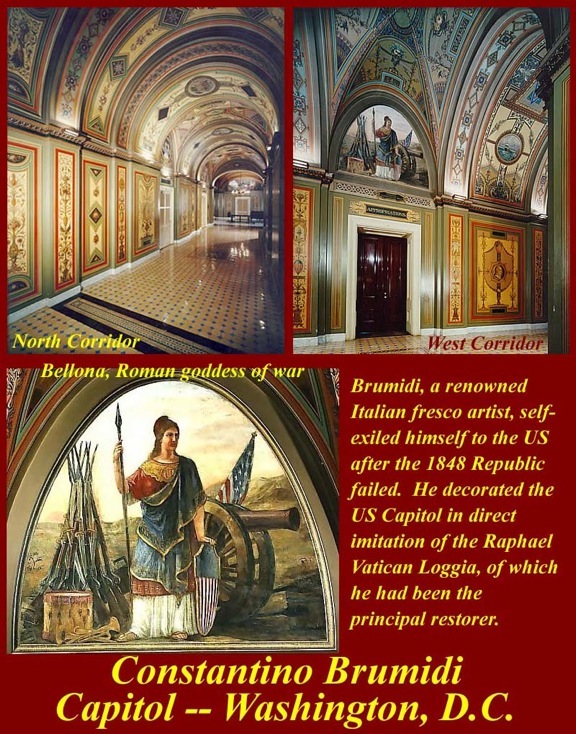
http://www.mmdtkw.org/RenRom0732-BrumidiCapitol.jpg
http://www.mmdtkw.org/RenRom0733-BrumidiGrotesque.jpg
Brumidi was an Italian/Greek-American historical painter, best known and honored for his mannerist 19th century fresco work in the Capitol Building in Washington, DC.
He was busy restoring Raphael's stanze in the Vatican when Garibaldi's and Mazzini's 1848 Roman Republic was thrown out by the French who were acting as protectors of the Papacy. The occupation of Rome by French forces in 1849 apparently persuaded Brumidi to emigrate; he had joined the short-lived risorgimental Roman Republic. He sailed for the United States, where he became a naturalized citizen in 1852. He painted a number of portraits and bigger works in New York, before he went to Mexico to take up a commission in the Mexico City Cathedral of the Holy Trinity. On his way back to New York, he stopped in Washington DC where he saw the large unpainted surfaces of the Capitol. He offered his services and was hired by Quartermaster General Montgomery C. Meigs. His Capitol frescoes are very much in the post -Renaissance Roman mannerist tradition. His grotesques, however are very much American -- native American creatures climbing native American vines rather than the European animals and vines that he saw in Raphael s grotesques.
Brumidi's Corridors in the Capitol are at http://en.wikipedia.org/wiki/Brumidi_Corridors, and his allegorical Apotheosis of George Washington in the central dome is at http://www.aoc.gov/cc/art/rotunda/apotheosis/index.cfm. Additional Capitol art by Brumidi and others is at http://www.aoc.gov/cc/art/index.cfm.
Sir Edward Coley Burne-Jones, 1st Baronet (28 August 1833 – 17 June 1898)
http://www.mmdtkw.org/RenRom0734-BurneJonesSPauls.jpg
Sir Edward Coley Burne-Jones, 1st Baronet (28 August 1833 – 17 June 1898) was a British artist and designer closely associated with the later phase of the Pre-Raphaelite movement, who worked closely with William Morris on a wide range of decorative arts. In addition to painting and stained glass, Burne-Jones worked in a variety of crafts; including designing ceramic tiles, jewelery, tapestries, mosaics and book illustration. In the 1870, shortly after the addition of Rome to unified Italy Burne-Jones was chosen to decorate the new American Episcopal Church in Rome, St. Paul's Within the Walls, the first ever Protestant church in the city. Burne-Jones designed Pre-Raphaelite mosaics which were assembled in Venice, dismantled, and the reassembled in the Church -- mad to measure. Like earlier Roman art, these mosaics -- especially the "heroes" section in the lower register behind the altar -- used the features of contemporary notables. In the section shown are Grant, Garibaldi, and Lincoln. Banker J.P. Morgan, and explosives manufacturer Alfred Nobel are said to be in there too, but I haven't been able to identify them.
A short bio of Burne-Jones is at http://en.wikipedia.org/wiki/Edward_Burne-Jones.
Images of the Mosaic are at http://www.victorianweb.org/painting/bj/mosaic/.
Other Burne-Jones art is at http://www.artcyclopedia.com/artists/burne-jones_edward.html and http://www.abcgallery.com/B/burne-jones/burnejones.html.
Leonardo di ser Piero da Vinci, (April 15, 1452 – May 2, 1519)
Leonardo was not a particularly active artist in his few years in Rome (1513-16), but we just can't leave him out.
http://www.isabelperez.com/wizard/leonardo_archivos/77946_1.jpg
https://en.wikipedia.org/wiki/Leonardo_da_Vinci#/media/File:Francesco_Melzi_-_Portrait_of_Leonardo_-_WGA14795.jpg
https://en.wikipedia.org/wiki/Leonardo_da_Vinci
http://www.artcyclopedia.com/artists/leonardo_da_vinci.html
http://www.mmdtkw.org/RenRom0735-MonaTellsLeonardo.jpg
Mona tells Leon.

